“Gorogoa” is a Gorgeous, Dreamy Puzzle Experience That’ll Let You Put Your Stress on Hold
In less than one month my wife and I will become parents (which excites and terrifies me in equal parts to see written out like that). As we’ve been counting down the weeks until her due date, our lives have become a blur of baby-related activity. Some of it’s been physical, like painting the nursery and putting together furniture; some of it’s been mental, like trying to decide on a name or worrying about the baby’s wellbeing — but all of it is exhausting. I usually find puzzles to be soothing when I’m stressed so I decided to check out Gorogoa, which was recently released on PS4.
Gorogoa caught my eye mainly for two reasons: 1) the illustration style looked very pretty and I am a sucker for pretty things and 2) it was put out by Annapurna Interactive, the same publisher that previously released What Remains of Edith Finch. That game ended up being one of my favorites of 2017, so I was willing to pick up Gorogoa without doing any additional digging and I’m so glad I did.
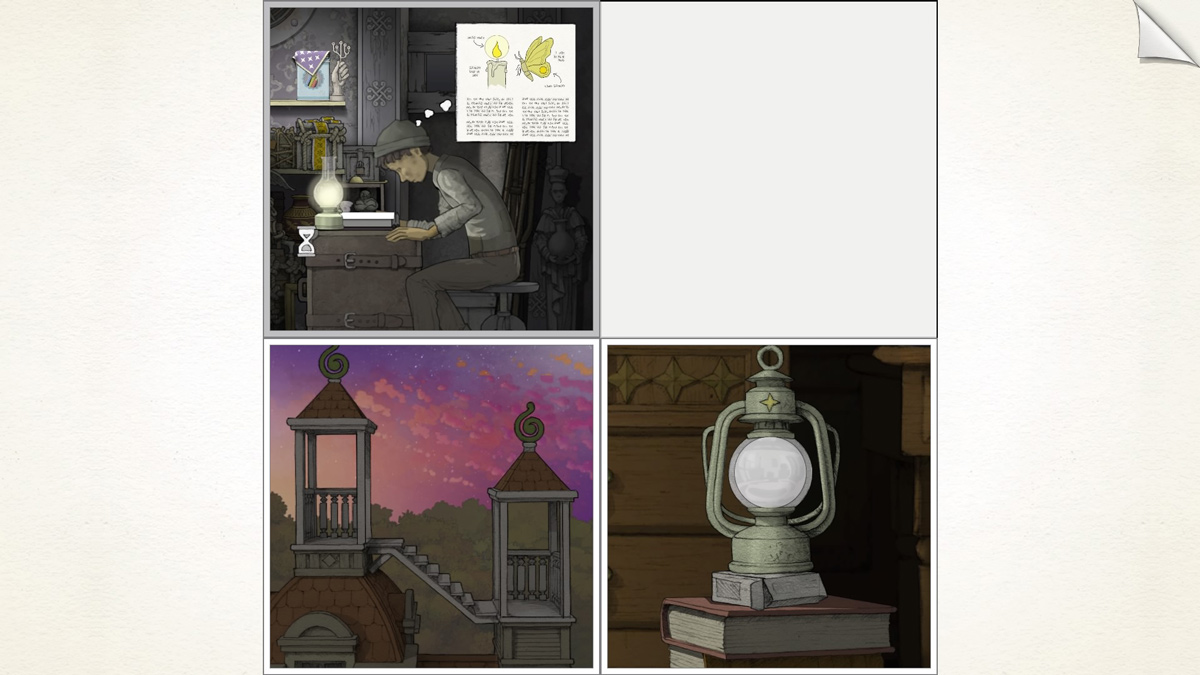
So many of the screens are intricate and soft and lovely.
This game was exactly what I needed: a couple of hours where my busy brain could focus on tangible puzzles with achievable solutions. Gorogoa’s interface is deceptively simple; it’s just a 2×2 grid of square spaces that can be filled with up to four illustrations at one time. Within those four illustrations, however, there are tons of possibilities for ways the pieces can fit together. Sometimes you need to match up the edges (the closest thing to a traditional jigsaw-style puzzle in the game), but other times you might need to zoom in, pan around or even layer pieces on top of one another to complete the scene.
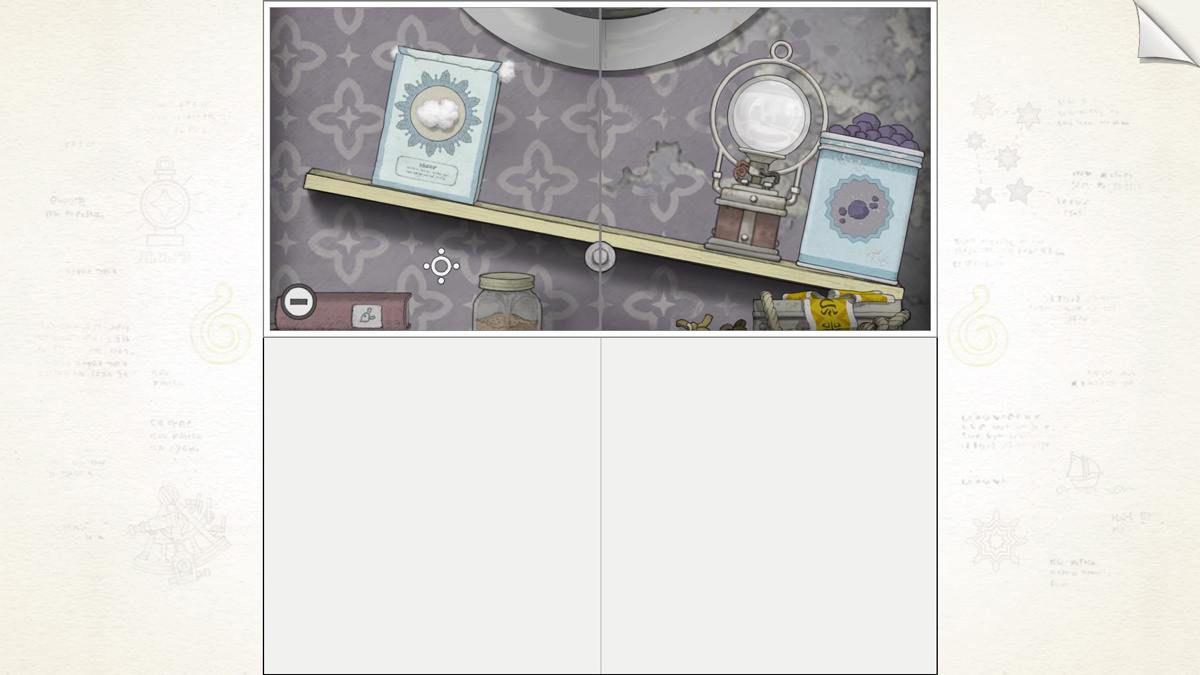
In this case, I had to figure out how to get the lantern from one side of the shelf to the other.
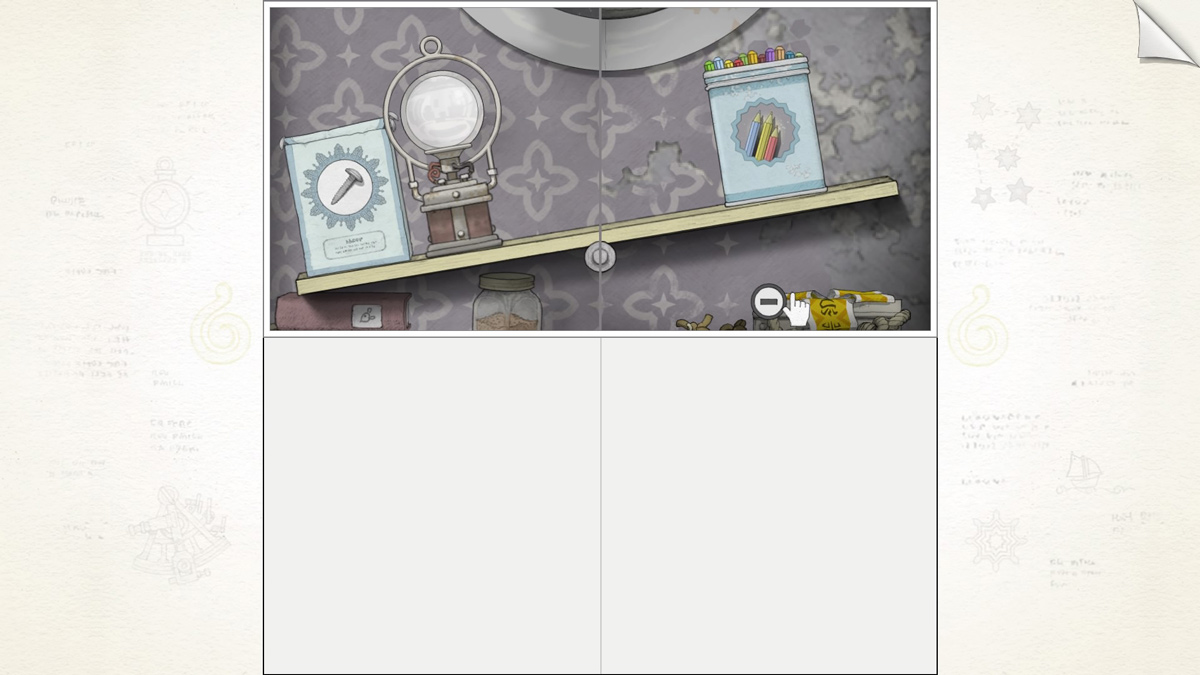
The puzzles range from quick and obvious to challenging, but even on the more difficult parts I never got stuck to the point of frustration. Just like with a physical jigsaw puzzle, Gorogoa sometimes requires you to check every configuration before you see the right one. There were definitely a few puzzles where I looked at the same pieces four or five times before realizing that the solution was in front of my face.
And do you know that feeling when you finally find a fit for a jigsaw puzzle piece that’s been driving you bonkers for a while? Like maybe you’re already half-convinced that your cat lost the corresponding piece(s) and you will spend the rest of eternity trying to finish a puzzle that’s impossible to complete? But then! Then you find that puzzle piece’s perfect little home, and it’s such a good feeling! Do you know that one?
Well, in Gorogoa that feeling is even more satisfying, because when you fit things together they animate and change and open up whole new puzzles you didn’t even know were there! Pure delight is the only way I can describe it.
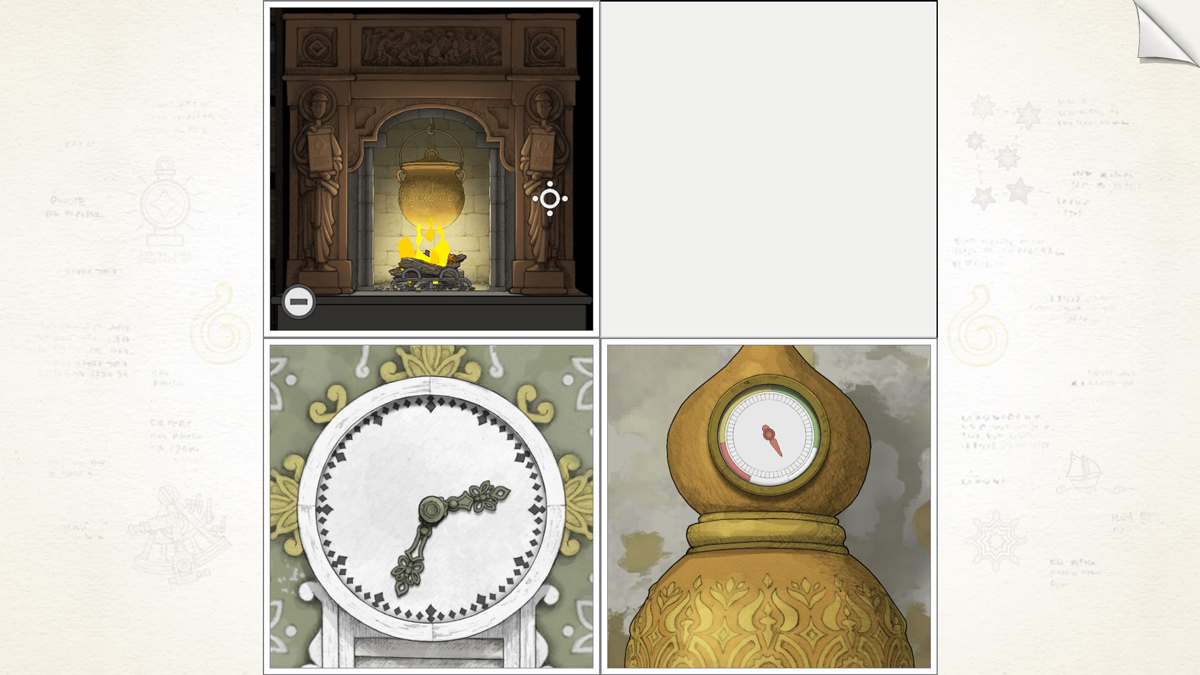
Rube Goldberg eat your heart out.
Unlike Edith Finch, which is all about a single family and the stories that shape them, Gorogoa focuses way less on the narrative. I guess if I had to try to sum it up, I would say Gorogoa is a non-linear story about a kid trying to collect fruit for an offering to a dragon-esque creature that may or may not be evil.
The thing about it was – and maybe I only felt this way because of how stressed out I’ve been – I didn’t care about the specifics of the story one bit. Even after finishing the game, I don’t know whether some of the secondary characters are just older versions of the main kid or are totally different people. I’m still not sure if the dragon monster is a destroyer or a savior.
Usually I focus on a game’s story, but something about the dreamlike quality of Gorogoa and, specifically, the art, made the lack of concrete narrative completely work for me. It’s melancholy and beautiful and ominous and sad in ways I can’t fully put my finger on. I just know I loved floating through it, being delighted by all the details.
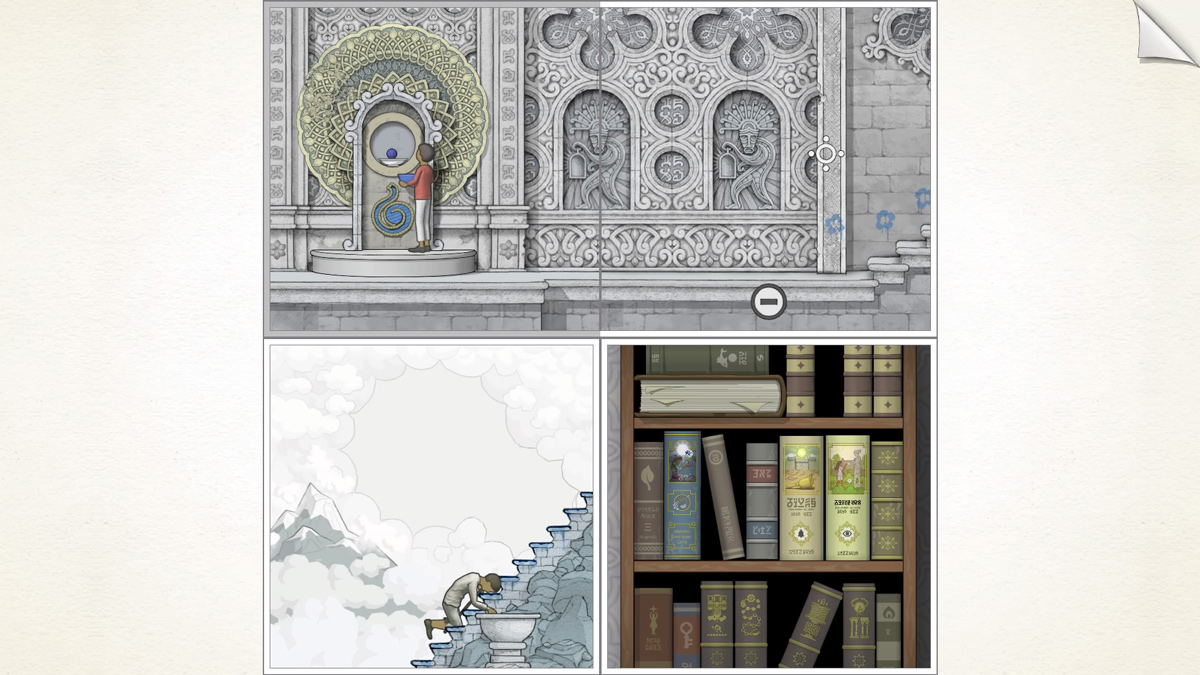
iOS was one of the first platforms Gorogoa was released on, and I imagine it might be even better as a mobile experience. You’ll be able to get closer to all the gorgeous illustrations, and the mechanics of swiping or pinching to zoom make sense for a game like this. It’s also a little more cost-effective at $5 versus the $15 I paid for PS4, which is maybe slightly on the higher end considering the game only takes a couple of hours to finish. But, to be honest, I would’ve gladly paid a few more dollars to get lost in Gorogoa’s dreamy puzzles for just a little longer.
Gorogoa is available on PS4, Xbox One, Steam, Nintendo Switch, and iOS.
Even My Soft Butch Hufflepuff Dreamboat Couldn’t Redeem the Cash-Grabbing Mess of “Hogwarts Mystery”
When I turned sixteen, my mom wanted to throw me a big party. You know, Sweet Sixteen, and all that. I told her absolutely not, that I’d much prefer to save us all a lot of stress and money and celebrate my birthday in my favorite way: by ignoring it. We ended up sort of compromising, and I brought a bunch of friends to see Harry Potter and the Sorcerer’s Stone when it premiered instead. If I had to acknowledge my birthday, I was going to at least enjoy Harry Potter while doing it.
Like so many other queer kids, I had fallen in love with the wizarding world — with its mail-delivering owls, and chocolate frogs that jump — almost immediately. Hogwarts was a place where being different was something to be celebrated, not hidden, and that sounded like heaven to my closeted teenage ears. I’m not a kid anymore, and I came out a long time ago, but I still love Harry Potter with all of my heart. So it really does pain me to tell you that the new mobile game, Hogwarts Mystery, makes me want to smash my phone into a million pieces.
None of the sense of wonder that made Harry Potter special is anywhere to be found in Hogwarts Mystery. Instead, the game is a hollow and nearly unplayable attempt to cash in on a billion-dollar franchise. It’s advertised as a narrative/RPG-style game “where players can create their own character and experience life as a Hogwarts student,” but none of the choices you make seem to actually impact the story in any meaningful way.
The general plot of Hogwarts Mystery is that your older brother tried to find some Cursed Vaults in Hogwarts, but something went wrong. He was expelled and has since disappeared. It’s your turn to start at Hogwarts now, and you’re determined to figure out what happened. As far as story set-ups go it’s fine, I guess, but the notoriety surrounding you because of things you didn’t do (and don’t really know about) plays out a lot like the beginning of Harry Potter. You even have your very own version of Draco Malfoy named Merula, a pure-blood obsessed Slytherin who despises you from the get go.

Not All Slytherins.
One of the only good things about Hogwarts Mystery is that I was able to create the softest butch imaginable from a pretty limited character creator. She also makes consistently hilarious facial expressions, like this one:
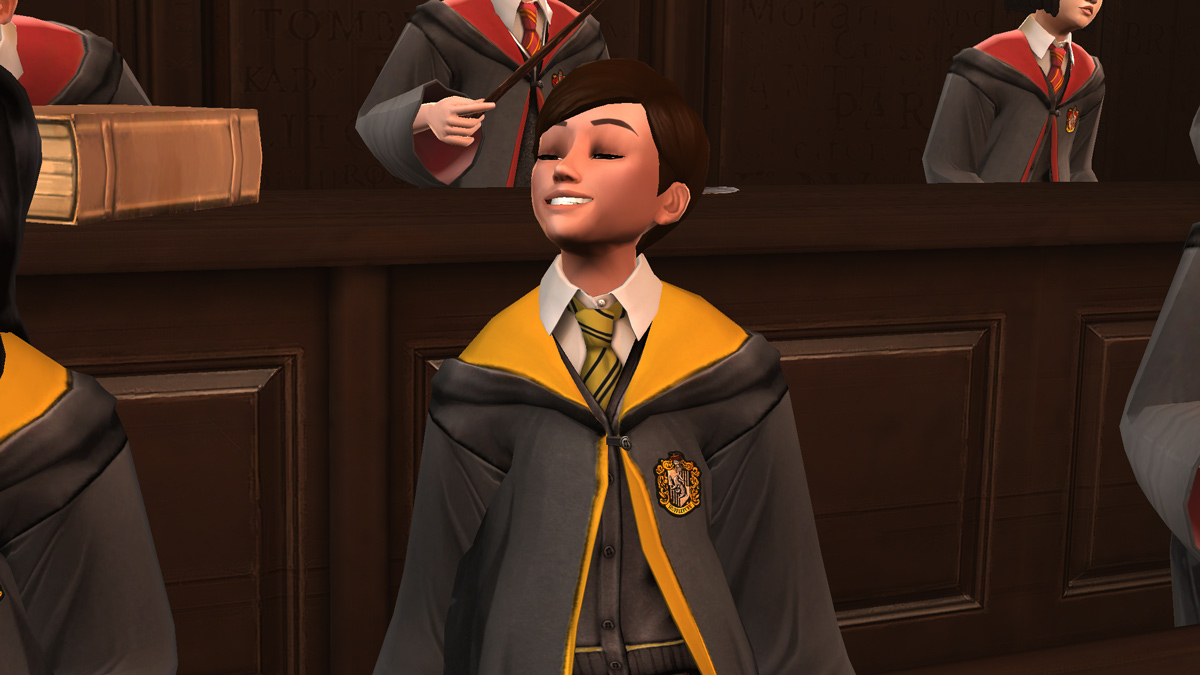
Look at this dork.
Once you create your character, there’s a brief tutorial that introduces the gameplay. Gameplay is a term I am using very loosely here, because the main mechanic, and probably about 85% of the game so far, is tapping on anything that is outlined in blue. I figured I would just go with it, even though it was repetitive and boring, in hopes that the game would pick up once I actually made it to Hogwarts. Reader, it did not.
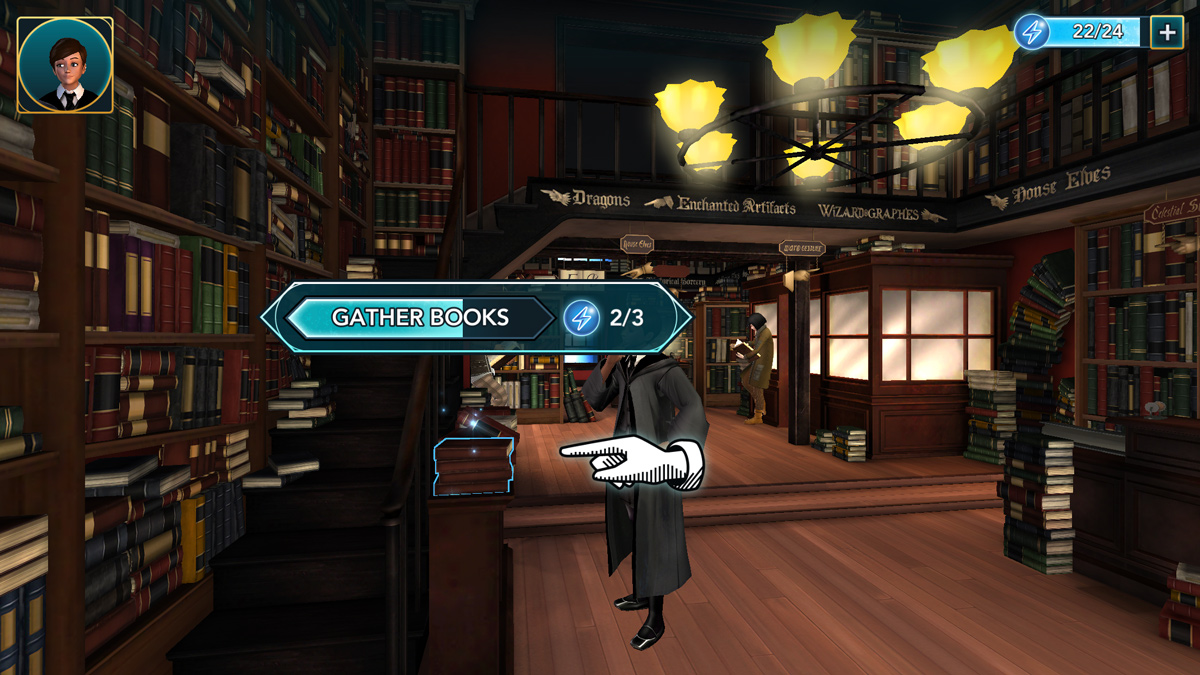
TAP HERE. FOREVER. YOU’LL NEVER STOP TAPPING.
In fact, the very first time there’s any excitement at all, the game hits a wall. You see, the little blue lightning circles were actually “energy” all along and it turns out you only have a finite amount of energy to complete tasks, which was somehow not really covered in the tutorial. So here you are, being literally strangled to death by Devil’s Snare:

And suddenly you run out of energy! Never fear though, you can just buy more energy with gems. Easy enough, right? But what if you run out of gems (which you will surely do all the time)?
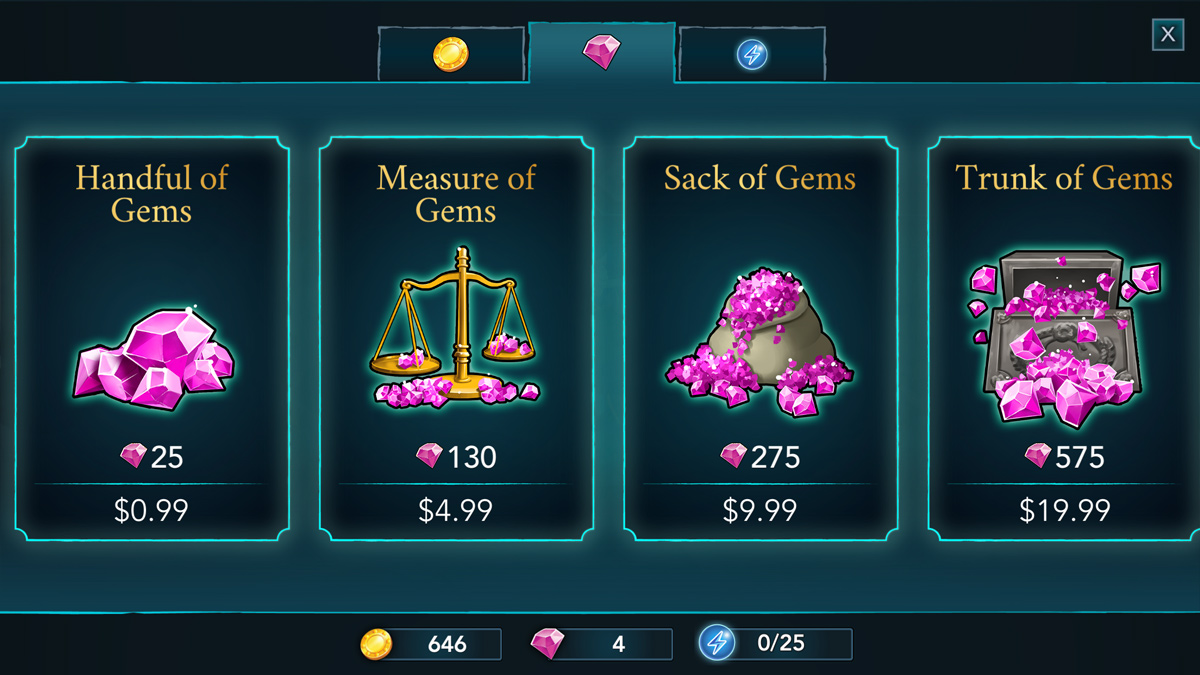
Oh.
So at this point your options are to shell out some cash or wait like an hour for your energy to recharge, which makes absolutely no sense given your current predicament. And that’s basically the whole game. Sure there are dialog options and choices to make, but the main choice of the game is this: do you pause and break up the flow of the story in inexplicable ways or do you pump money in to keep blindly tapping.
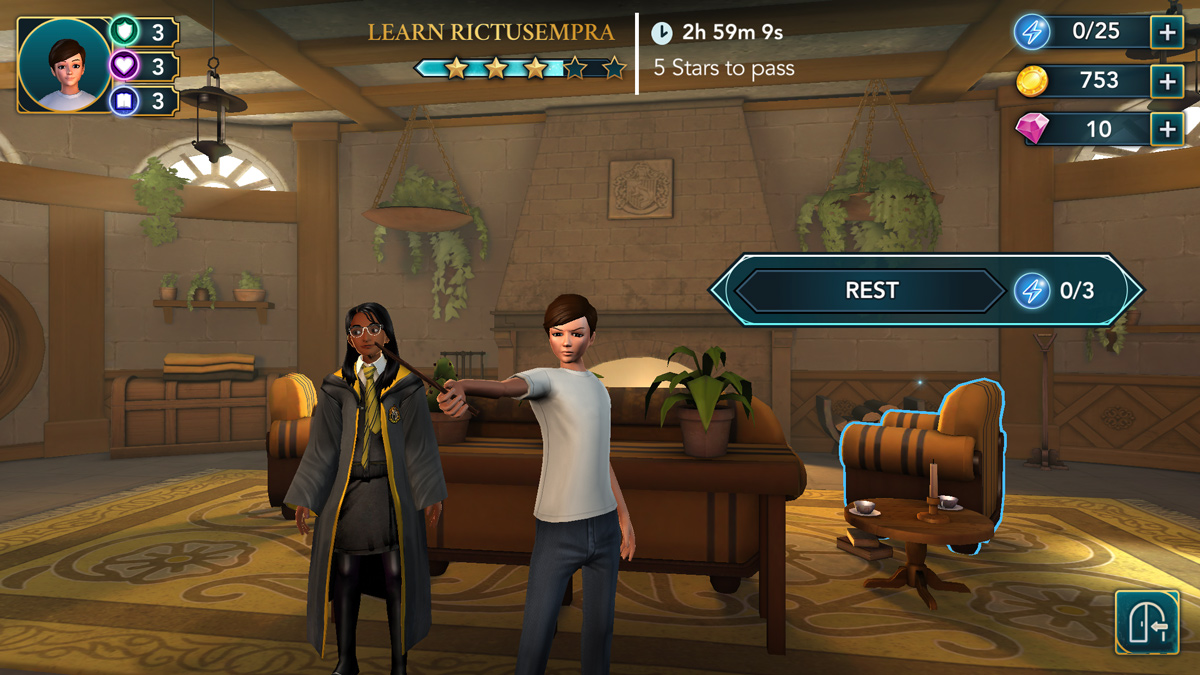
WHY DO I NEED ENERGY TO REST, THIS MAKES NO SENSE!!!
“Freemium” isn’t a new concept and Hogwarts Mystery isn’t the first game to use dark patterns in an attempt to make some money, but the blatant lack of effort to create an entertaining game here is disheartening. Puzzle games like Candy Crush that use a similar tactic work because there’s actually some level of skill involved; you want to keep playing to solve the puzzles.
In Hogwarts Mystery, the only thing that keeps you going is the story, which is… still fine, I guess. You mostly interact with Rowan, who becomes your best friend after you meet in Diagon Alley during the tutorial. She’s in your house no matter which one you choose, which is another thing that doesn’t make sense because she is so clearly a Ravenclaw:

She’s a cute nerd though, which is 100% my type, and if I don’t uninstall this game from my phone before year four or five I’ll probably try to romance her (if that’s even an option). Anyway, Rowan is down to help you investigate the Cursed Vaults and also help you learn to how to duel, which is another part of the game that I think was probably created by someone who has never read or seen any of the Harry Potters.
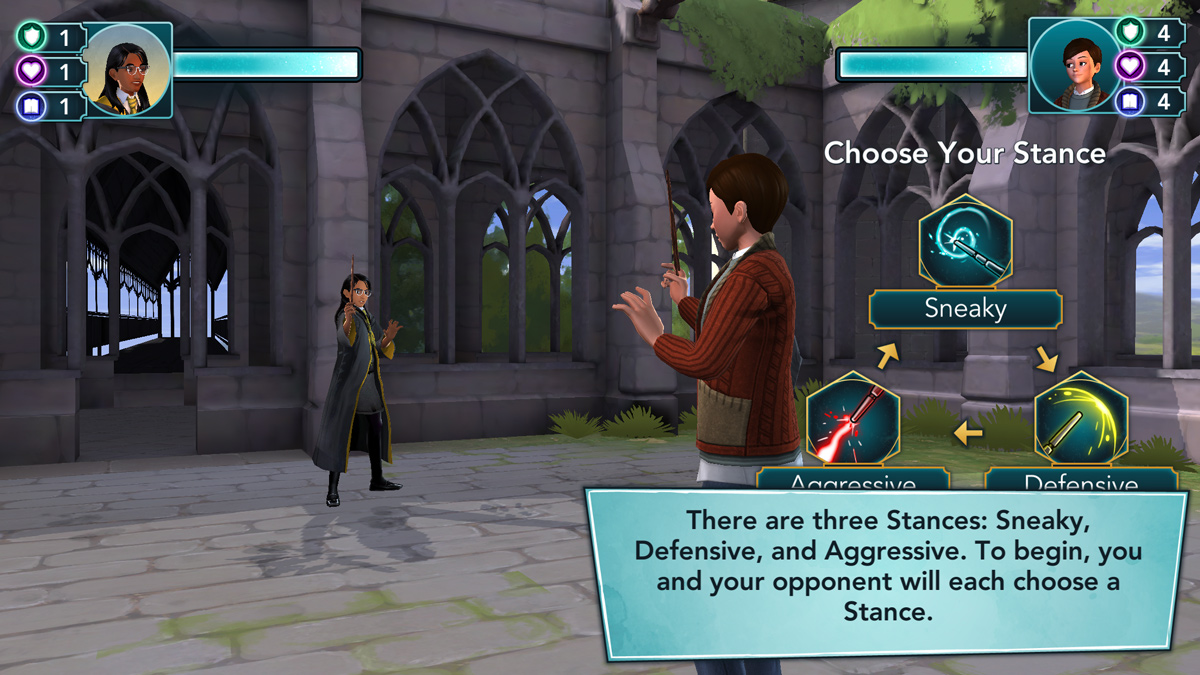
The way duels work in Hogwarts Mystery is that they’re exactly like rock-paper-scissors, and also sometimes if you win a round you can “throw a vial” to reduce your opponent’s stamina (which is definitely not a thing). It makes no sense, but it’s such a relief not to be tapping randomly at the screen that I don’t even care.
Throughout your first year, you also meet a few more friends named Penny Haywood and Ben Copper. Ben is a cowardly Gryffindor and mostly a boring character, but Penny is a total babe with a heart of gold. She takes an interest in you because you stand up to Merula’s bullying and beat her in a duel, like a badass. Penny starts talking to you and reduces you to a stammering gay disaster, which is the truest part of the whole game so far.
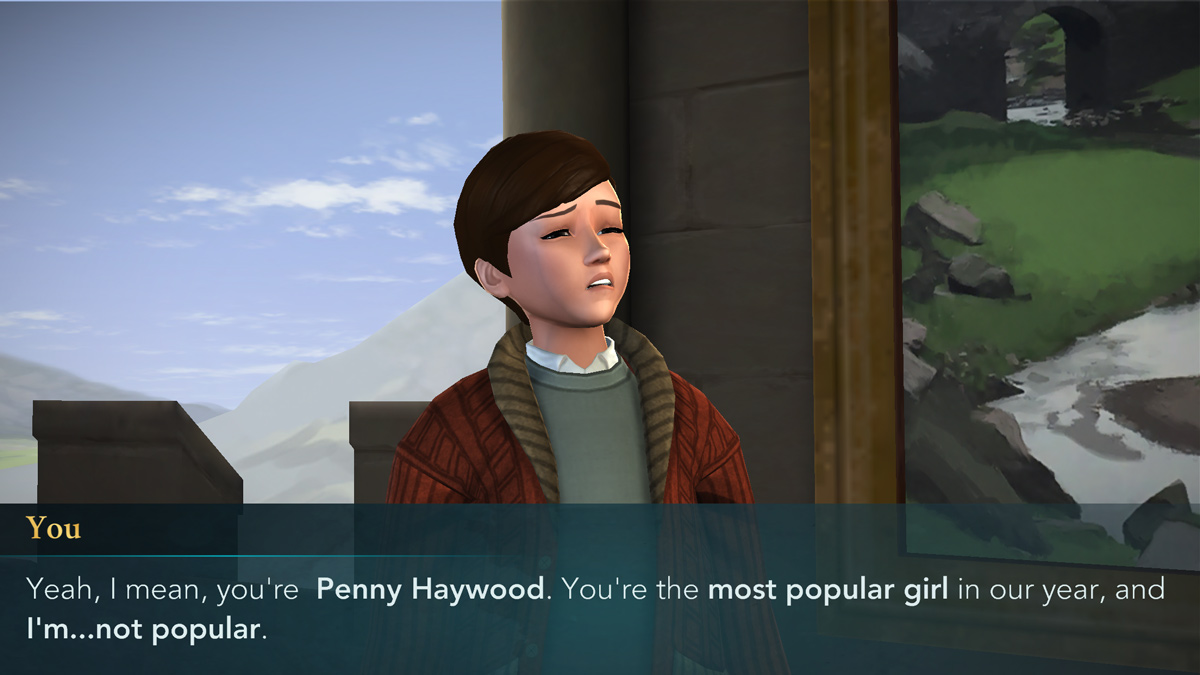
This is the collective queer reaction to every pretty girl.
At the end of the year, you can choose whether to take Penny or Ben (along with Rowan) on an adventure to try and find a Cursed Vault. Obviously, the correct answer is to take Penny, which I did, but apparently that choice doesn’t actually matter because in the beginning of the second year Ben is somehow the one affected by the trip. Hey look, it’s another thing that doesn’t make sense!
As of right now, the game is only playable into the third year, but I haven’t made it to that point yet because I’m not willing to spend a single cent on this thing. The idea of a Hogwarts RPG is such a good one, and it had the potential to be a robust and fun experience, but Hogwarts Mystery is a complete let down. Unless the developer, Jam City, makes some serious and fundamental changes, I do not recommend this incredibly frustrating game — even (or maybe especially) if you’re a Harry Potter fan.
“Celeste” Is a Very Difficult Video Game for People Who Know What It’s Like to Have Something to Prove
It should come as no surprise that I prefer narrative-driven games. They were the very first thing I wrote about on this here website, and I think close to half of the games I’ve reviewed since then have been visual novels. What can I say? I’m a sucker for a good story, so I usually prioritize that above perfect mechanics or exceptionally challenging gameplay.
I’ve been playing Horizon Zero Dawn for the past few months, and I was first drawn to it, as usual, because of Aloy and her story. (And, well, because Ashly Burch. Duh.) And although I did for sure engage with the story from the beginning, it wasn’t until the first combat that I was fully hooked. I mean, holy smokes! I get to hunt and ride giant robotic dinosaur things? That’s cool as heck. Even though the controls are complex, everything feels remarkably intuitive and challenging in a good way.
It’s very possible that the approximately one million combat hours I’ve put toward HZD so far might be why — for the first time in recent memory — I sought out a game specifically because of its gameplay instead of just its story. Celeste is that game, and I’m here to tell you that it turns out that it’s is so much more than just a collection of very difficult levels. (But it’s definitely that, too.)
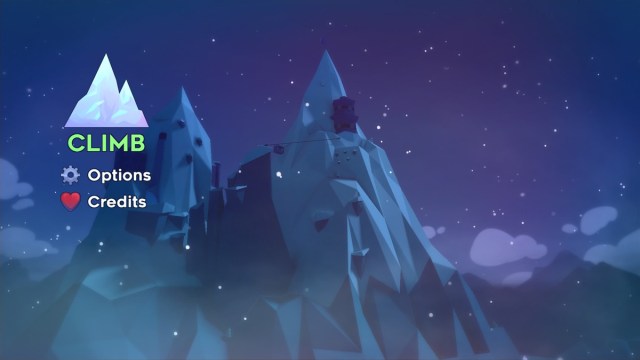
Just keep climbing.
Celeste is a game about a girl named Madeline. She has come to the notoriously perilous Celeste Mountain with a single-minded focus: she will reach Celeste’s summit no matter what. It becomes clear pretty quickly that Madeline is at a crossroads in her life, though we never find out exactly what events led her here. What we do know is that she feels like she has something to prove — to strangers, to her mother, but mostly to herself.
It’s incredibly relatable. Who hasn’t, at some point in their life, wanted (or needed) to do something big and tangible to prove that they aren’t a failure? Maybe your goal, like Madeline, is to climb a mountain, or maybe you want to run a marathon or to finish that novel, or whatever just popped into your head as you were reading this — whatever that thing is — it’s something you can point to and say, “Hey. I’m not a total fuck up, see? I did this.”

Getting there, though, is no easy feat. Celeste’s gameplay is probably the most challenging I’ve come across. There were multiple stages that I stared at for seconds, or even minutes, before attempting, because they looked actually impossible to complete. The main controls are fairly limited: you can move, crouch, jump, dash, and hang onto or climb vertical surfaces (but only for a limited time — stay there too long and you’ll slide down). The trick is combining them in just the right way; dash a split second too late or land a few inches too high on a wall and you’re dead.
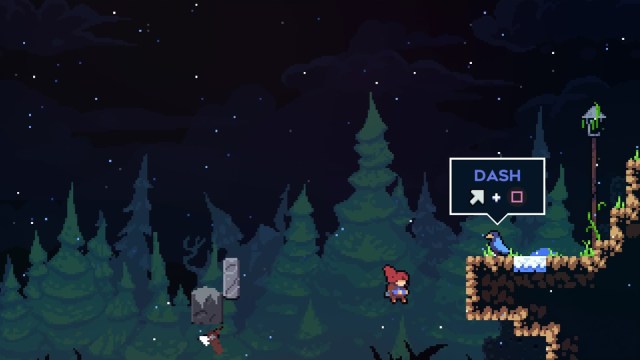
Thank you bird friend!
And I sure did die a lot! Like, hundreds of times each level amount of a lot. Thankfully, it’s not permadeath (I think then it really would be impossible) and you rarely lose more progress than whatever you can see on the screen at the time. The game evolves as you make your way up the mountain, with new challenges like fire and wind appearing at different points. Luckily, the game also introduces mechanics to help, too — things like green diamonds that give you an additional air dash if you pass through them.
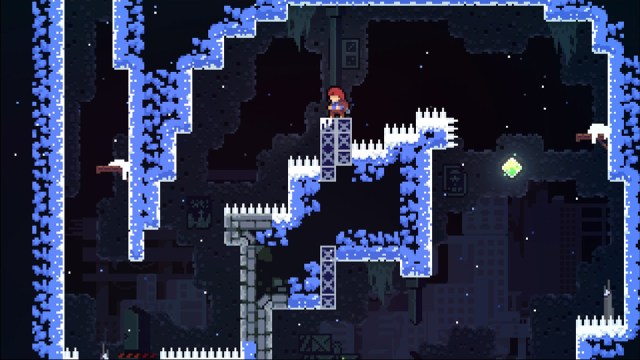
In retrospect, this is actually a relatively easy stage.
Even though the game is hard, Celeste lets you control how tough you want things to be with something called Assist Mode. Using Assist Mode, you don’t just change the level of difficulty using preset options, you can instead adjust specific features to decide exactly how much help you need for any given stage. You can do something as minor as slowing the game speed down to 90%, or as major as turning on invincibility and giving yourself an infinite amount of air dashes.
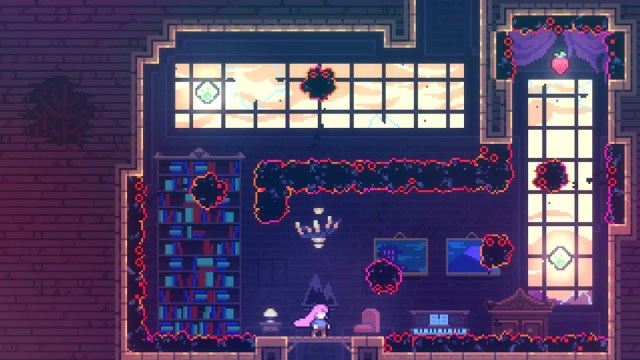
You can tell when invincibility is turned on because Madeline’s hair is pink
Visually, Celeste combines several different styles: 8-bit for the actual gameplay, smooth 3D modeling for the title/instruction screens, and illustration for the end of chapter scenes. On paper, it seems like it should probably be a disjointed hodgepodge of art, but somehow it works and each style brings a different dimension to the game. The color palette is consistently gorgeous, full of cool and vibrant tones, and it helps to tie everything together.

Not to be outdone by the visuals or gameplay, the sound throughout the game is also absolutely top notch. Celeste’s soundtrack is beautiful; the music scoring the mood of each stage perfectly, whether it’s triumphant or suspenseful or haunting or something else entirely.
And even though the dialogue is all written and only “spoken” in a vaguely adults-in-Peanuts kind of way, the voice acting is super expressive. When Madeline was scared or sad, her little voice hurt my heart. I’m not sure how to fully explain it, but it’s somehow very cute while being tragic and distressing all at the same time?
Also very cute is Theo, a fellow hiker that Madeline meets along the way. I will admit that I was a bit wary of him at first — I didn’t want Madeline’s journey of self-reflection to turn into a story about how the love of a boy can save you. Thankfully and happily I can tell you that there is no compulsory heterosexuality in Celeste! In fact, the most romantic vibes I got from the whole game were when Theo was maybe trying to set Madeline up with his sister. (At least, that’s how I read that scene.)
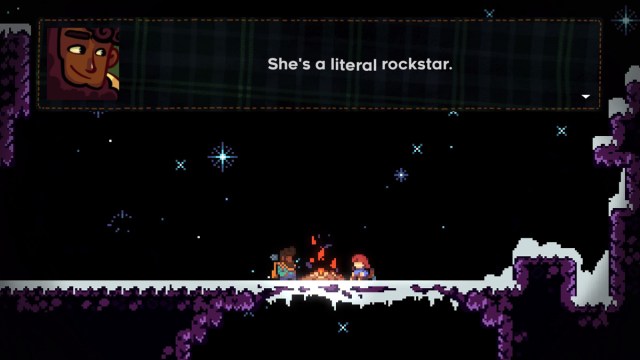
Wingman-Theo at your service
As they make their way up the mountain, Theo reveals himself to be a very good friend. He helps Madeline breathe through a panic attack and Madeline returns the favor later by rescuing him from a creepy temple. But even with Theo along for the ride, the story remains Madeline’s through and through. It’s all about Madeline’s obstacles — both on the mountain and within herself — and she doesn’t need any saving to overcome them.
And how does Madeline overcome her obstacles? Well, you do not have to worry about any specific ending spoilers here, because when I finished Celeste it was after playing D&D/drinking beers for several hours. I turned on the aforementioned invincibility and infinite air dashes, and I just absolutely tore through the last few chapters.
Way back toward the beginning of the game, when I first turned on Assist Mode, there was a disclaimer about how Celeste is supposed to be very challenging and that they recommend playing without help your first time through. At the time, I thought it was a little gimmicky, but now that I’ve finished the game using Assist Mode aggressively I do wish I had heeded the warning more seriously and used the features in Assist Mode as more of a last resort.
Even though (or maybe because) I didn’t complete all chapters of the game without help, I really enjoyed the resolution of Madeline’s journey. Along the way, her attitude shifts little by little. Madeline still wants to summit Celeste Mountain, but the desperate notion that all of her self-worth is tied up in this one climb slips away as she learns more about herself. It’s a really affirming and satisfying game, especially if you’re like me and tend to put a lot of pressure on yourself.
Celeste is available on lots of platforms — I played on PS4, but you could play on Switch or Xbox One or PC/Mac/Linux, whichever you want! I adored this game so much; I am already planning to attempt another playthrough without Assist Mode despite my ever growing “to play” list of new games.
“Butterfly Soup” and “GENDERWRECKED” Are the Queer Indie Games You’re Looking For
One of my big goals for this, the year of our lord (Hayley Kiyoko) 20gayteen, is to seek out more explicitly LGBTQ media. I am 32 years old and I’ve gotten real sick of relying on subtext or blink-and-you’ll-miss-it “representation” over the course of most of my life. These days, I constantly crave queer ass stories about queer ass characters. Give me soft butches in love and nerdy non-binary people saving the day; show me bi women solving mysteries and trans superheroes fighting against evil. I want all. the. queers.
Luckily for us all, there are some incredible indie game creators who are here to give the people what we want: gays! I played two games recently that made my heart dang near burst out of my chest in very different ways: Butterfly Soup and GENDERWRECKED.
First of all, thanks to all the commenters who suggested Butterfly Soup — you were 100% dead on and I welcome any of your future recommendations. Butterfly Soup is described as a “visual novel about gay Asian girls playing baseball and falling in love,” so if that didn’t already sell you then I feel like you might need to reevaluate your priorities in life.
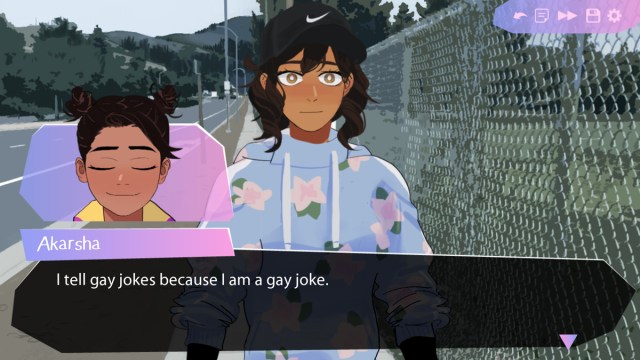
So many moments in this game are #relatable.
The length is fairly standard for a visual novel, about three hours total, and I loved every second of it. The game is split up into four sections; in each one you play from the perspective of a different main character, experiencing a mix of present day action and flashbacks to the girls’ younger days. The structure helps to establish the girls’ depth of character, and you really get to know and root for them all in a short amount of time.
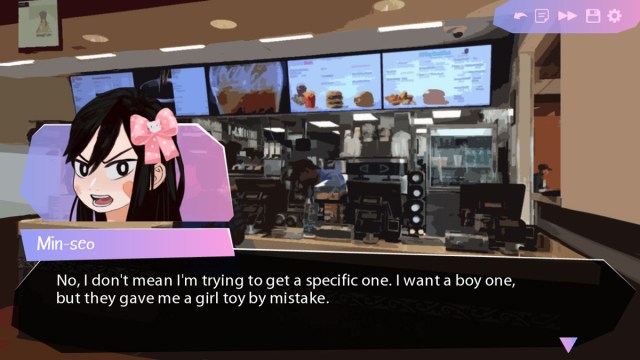
Who among us didn’t get angry at gendered toys when we were young?
In a lot of ways, Butterfly Soup is a classic coming of age story. It’s about a group of kids learning about themselves (and each other) as they try to navigate the world around them. They deal with pressure from their parents and stress out about having crushes; they fight with each other one second and joke around the next. But instead of focusing on a group of straight white boys, as so many coming of age stories historically have, Butterfly Soup is unequivocally Asian and female and queer.
A big pet peeve of mine is when straight creators or actors talk about their characters and describe them as people who “just happen to be LGBTQ.” And I think I understand the intention, well-meaning as it probably is. They’re trying to say, “Hey, we’re all humans and we’re not so different,” but it never fails to annoy me. My being queer does make me different from a straight person, and that’s not a bad thing. Because I’m queer, I’ve had different experiences and I have a different point of view — and that’s cool! You might also be queer, but have had a totally different life than me — and that’s great too! Diversity is really neat.
The girls in Butterfly Soup don’t just “happen to be gay” or “happen to be Asian,” those are quintessential pieces of who they are. And when authentic representation is at the core of the story instead of a peripheral afterthought, you get something that feels real and specific and somehow also universal. Even though I’m not Asian and I wasn’t out in high school, I was able relate to parts of all the characters. I feel Min’s rage at how unfair gender can be. I make jokes to cover up my insecurities, just like Akarsha. I empathize with the academic pressure put on Noelle. And most of all, Diya’s love of dogs speaks to me on a deep, spiritual level.
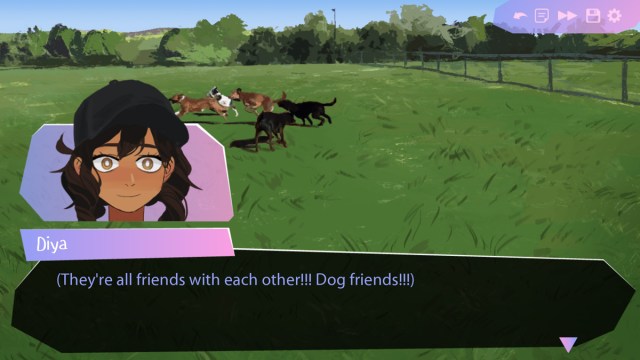
Actually me.
The game is really funny and almost painfully cute, and it somehow made me wish (for a very brief moment) that I could go back to high school — a feat I didn’t think possible. It also focuses on positive young queer relationships, rather than trauma or tragedy, which was a refreshing change of pace. You can get Butterfly Soup right here for PC, Mac, and Linux, and you can name your own price, so you should really do it right this second.
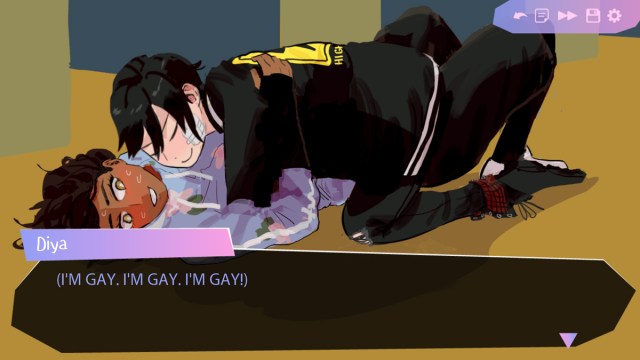
Actually all of us.
Like Butterfly Soup, GENDERWRECKED is a visual novel that tackles queer topics — in this case it focuses heavily on, you guessed it, GENDER. It’s shorter (only about an hour long) and stranger and far more figurative than Butterfly Soup, but that doesn’t mean it’s any less authentic or affecting.
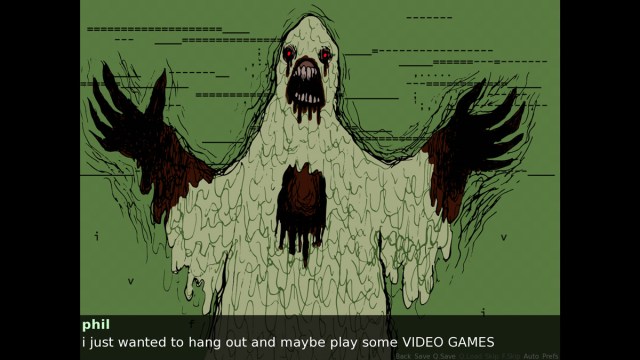
Even MORE #relatable content
In GENDERWRECKED, you embark on a quest to learn about gender by exploring a post-apocalyptic landscape of forgotten islands. While traveling, you encounter all sorts of monsters — some more friendly and helpful than others — and you can choose to interact with them in whatever way you think it will most help your quest. One way to learn about gender, apparently, is to make out with monsters, which I recommend 10/10.

Yes, yes, a thousand times yes!
Despite the game’s fantasy setting and bizarre cast of characters, GENDERWRECKED’s central quest felt real and solid and truthful to me. I have spent a lot of time thinking about gender (both as an abstract concept and how I personally relate to it), and I’ve often struggled to put words to my feelings. GENDERWRECKED is the first game I’ve ever played where I felt completely seen and understood as a person who tentatively identifies as genderqueer. This game provides so many beautiful descriptions of gender, it was almost overwhelming to see them all represented in one place.

Same.
GENDERWRECKED isn’t all heavy, though, there’s actually a nice balance of absurd humor mixed in with the more serious conversations. Plus, you get to wrestle with Jolene, who is a tree.

Your beauty is beyond compare
I really can’t recommend this game enough, especially for folks like me who have had a tough time articulating their gender or even knowing how or where to start thinking about gender. While the game is quite short, the characters are memorable enough that you’ll probably want to play it more than once. You can get started on your very own GENDER quest here for PC, Mac, and Linux.

Here’s to hoping the rest of the year is filled with as many wonderful queer games as these first few months have been! I’ve already heard about one called DATE KNIGHT, “a light hearted comedic LGBT dating sim where you date gender ambiguous knights,” which you can support on Patreon if you’re able to.
What queer games are you looking forward to over the next few months?
This Queer House, Vol 10: New Year, Newly Organized Queer House
New Year’s resolutions don’t work for me. They’re are too absolute, too black and white, to ever be realistic for my lifestyle. For instance, I have already broken every 2018 resolution I made — both the ones I said out loud and the ones I kept in my head. But I also love New Year’s Resolutions! They represent all those wonderful concepts of change and growth and striving to be better, however you choose to define it. In that spirit, January’s This Queer House is all about organizing your space.
What You’ll Need:
- Cleaning supplies – The actual supplies will depend on what kind of space you’re organizing. A whole room? You’ll want a vacuum or broom and mop. Just tackling your desk? Maybe a spray cleaner is all you need. (See the end of the column for an all-purpose DIY cleaner recipe.)
- Scrap paper and marker/pen
- Space – Be prepared for this project to take up more physical space in your home than you expect it to.
What To Do:
1. Identify the area. If you’re overwhelmed by the idea of organizing your home, it’s totally okay to start small. Instead of trying to declutter a whole room right off the bat, just aim to organize one section — maybe a shelf or other surface that tends to collect junk. For our project, my wife and I chose the guest room closet and surrounding area.

Our guest room closet aka the place where random junk goes to die
2. Completely empty the space. This is where having extra room will come in handy. Things will definitely get worse before they get better, and it’s good to just let the mess expand at this point.
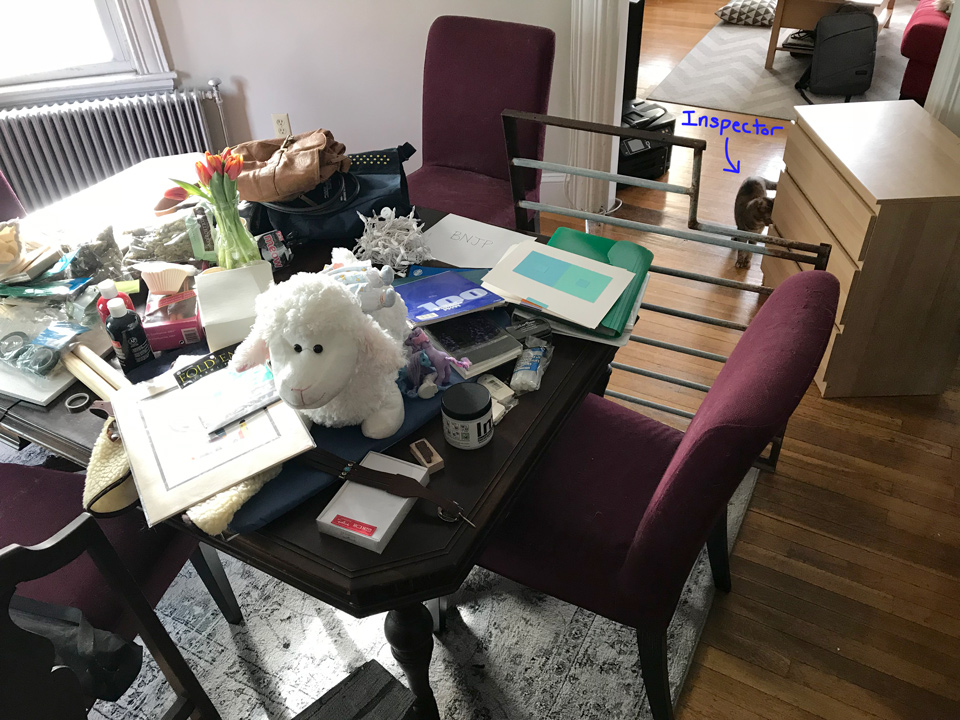
Taking over most of the house
3. Sort everything. Use the paper and marker to make signs so you can group various types of stuff together. If you have enough space, it can be helpful to create piles in different rooms so things don’t accidently get pushed from one heap to the other. For our closet, we grouped things by the following categories:
-
- Trash/shredder
- Donate/give away
- Move to basement
- Keep in closet

We tried to limit the “keep in closet” pile as much as possible
4. Clean thoroughly. This is your chance to really deep clean a spot that may not usually get much attention. Maybe I’m weird, but I find that extremely satisfying.
5. Implement an organization system. Once you’ve gotten rid of the trash/donate piles, it’s time to put things away. The goal here is to set up a system that will allow you to use your space well — and won’t devolve into a total mess again in a few months. Think realistically about which items you truly need often so they can be the most accessible, and give every item, no matter how small, an assigned place.

This closet is now much less anxiety-inducing for me!
And there you have it! It’s okay if your end result isn’t completely bare and minimal and perfect; the most important thing is feeling in control of the spaces you create. As I mentioned before, you can apply this basic technique to any or every part of your home to get organized in 2018.
All-purpose cleaner recipe
My wife and I use this daily for general surface cleaning around the house and it works great! Every now and then we have to bust out the big guns for the stove (Magic Eraser), but this spray is perfect 90% of the time.
- 1 part water
- 1 part white vinegar
- A few drops of dish soap (you can use essential oils instead, but we never have any)
Author’s note: this is my last monthly This Queer House column, but I’ll still pop up every now and then with new DIY projects and crafts. Please do let me know if there’s something you want to see here in the future! You can email me at jenna@autostraddle.com or find me on twitter @jennalykes.
“Doki Doki Literature Club” Doesn’t Subvert Dating Sim Misogyny as Much as It Thinks It Does
Early 2018 is shaping up to be pretty thin when it comes to video game releases I actually care about. Sure, I’m looking forward to the new Tomb Raider and Mega Man games (and honestly I’m all in for Death Stranding, whatever the heck that ends up being), but the beginning of the year is a bit boring. I looked back at a few “Best of 2017” lists to see what games I missed, and an Indie game called Doki Doki Literature Club piqued my interest.
DDLC is free (or pay what you want) on Steam or itch.io and only takes a few hours to complete. The game ends up turning into something totally different than it seems at first glance, so if you really want to play it I would urge you to do two things:
- Take all the disclaimers very seriously and decide whether or not you actually want to proceed.
-
If you’re sure you’re okay to play, jump into the game without reading anything more about it.
(This is the part where I tell you there will be spoilers below, but I promise I won’t include anything too graphic.)
It’s clear that DDLC wants to subvert your expectations from the moment the game opens. Three different content warnings are displayed before you even get to the main option screen, but they’re paired with bubbly anime-style graphics and light, fun music.

This seems fine.
After agreeing to the disclaimers, the game starts off like most romantic visual novels. You play, unfortunately, as a teenage boy who is kind of a jerk. Your childhood friend, Sayori, insists that you need to take up an after school activity, and she has the perfect one in mind: the Literature Club! You go along with her, though you have no intention of joining — that is until you find out that the club is full of cute girls.
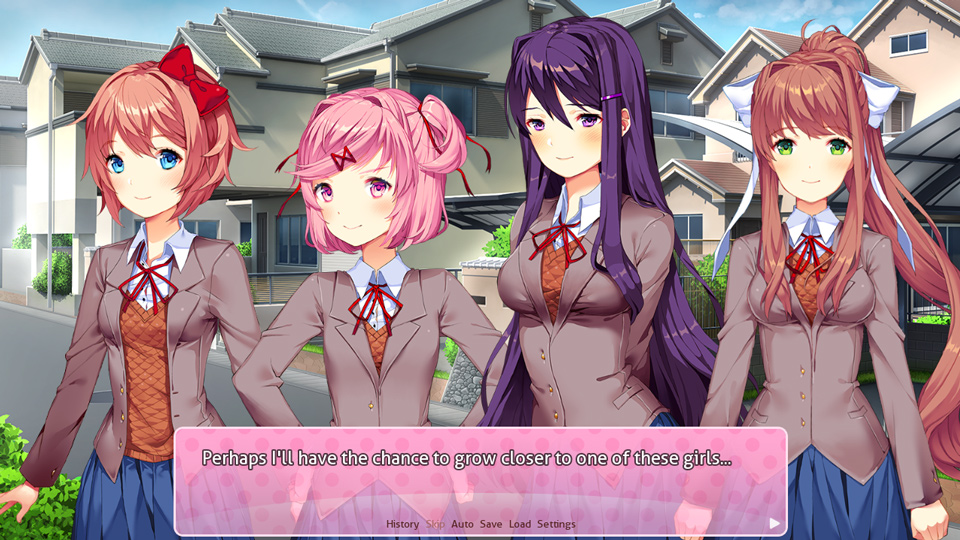
Perhaps NOT.
Lack of female agency is a long-standing trope in dating sims, and DDLC leans on it heavily at the beginning of the game. As soon as you arrive at the Literature Club, it’s clear that the girls are automatically yours for the choosing. But instead of actively trying to steer my character toward anyone, romantically, I hoped that they would all just date each other.
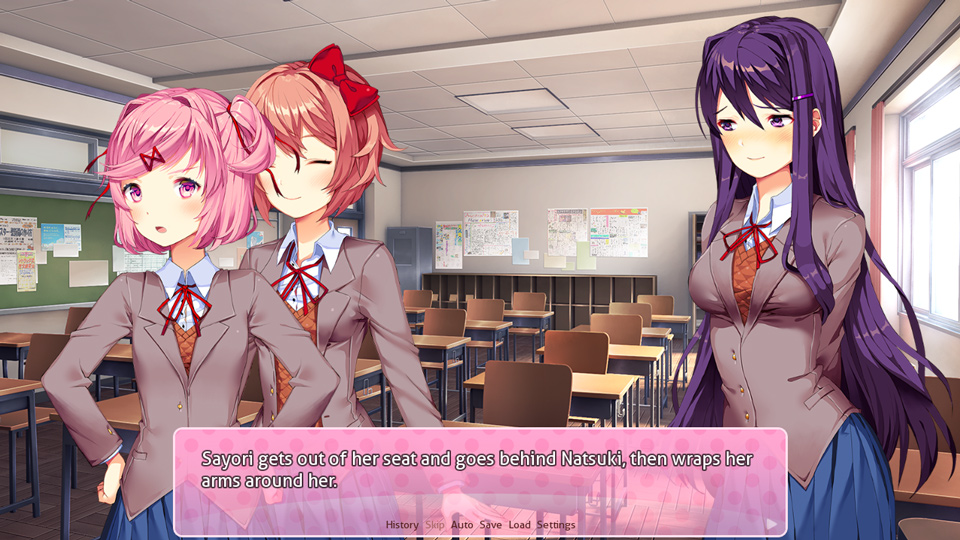
Yes, I would like more of this please.

Early on, the main game mechanics are simple; even for a visual novel, DDLC is on the light end of the interactivity spectrum. The only choices you can make are which words to include in the poems you write for the Literature Club and which girl you want to share them with first. The rest of the first act establishes the characters, as well as including a whole heap of foreshadowing and a vague sense that things are not quite right.
Because I knew a bit about the game’s plot before I started playing, I found myself impatiently waiting for the shift from romance into horror. I expected the twist — Sayori’s suicide — to happen suddenly (like a jump scare), but instead the game establishes her depression early. By the time you’re about to find her body, you can guess exactly what’s happened. Your character blames himself and his choices, but Sayori’s suicide is inevitable.
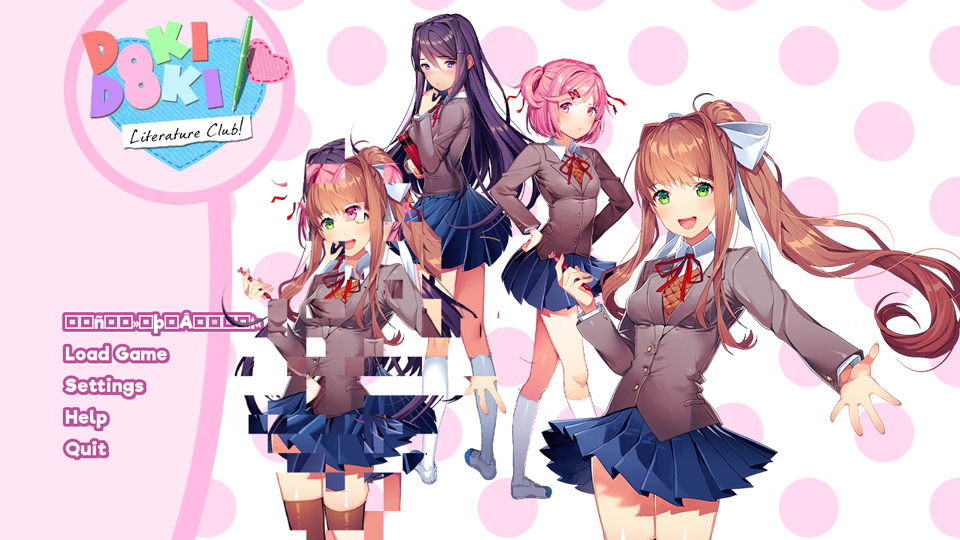
GET IT?? It *is* a game.
Sayori’s death is the turning point for DDLC, and now shit really starts to get weird. After ostensibly ending quite abruptly, the game reloads the main option screen — but this time some of the content is corrupted.
The second playthrough begins as though Sayori never existed, though the game glitches in the places she is supposed to be directly referenced. In this universe, you join the Literature Club because of Monika, the club’s president, instead of Sayori. The game gets increasingly unsettling as the other two remaining girls in the club, Yuri and Natsuki, viciously vie for your affection.

Nightmare material
In this playthrough, Monika’s interference becomes more and more obvious: she breaks the fourth wall, she seems to be controlling the actions and memories of the other girls, she limits your choices in the game so you can pick “Just Monika.” Things come to a head when another of the girls, this time Yuri, kills herself violently, and you are left alone with her body for a whole weekend.
Monika apologizes for the game’s broken script, deletes Yuri and Natsuki’s character files, and takes you away to an empty room. Monika’s known it’s a game the whole time, you see, and all she wanted to do was make you fall in love with her. And it’s such a disappointing reveal! The game acknowledges the lack of female agency in the genre, but makes no actual attempt to subvert the trope.
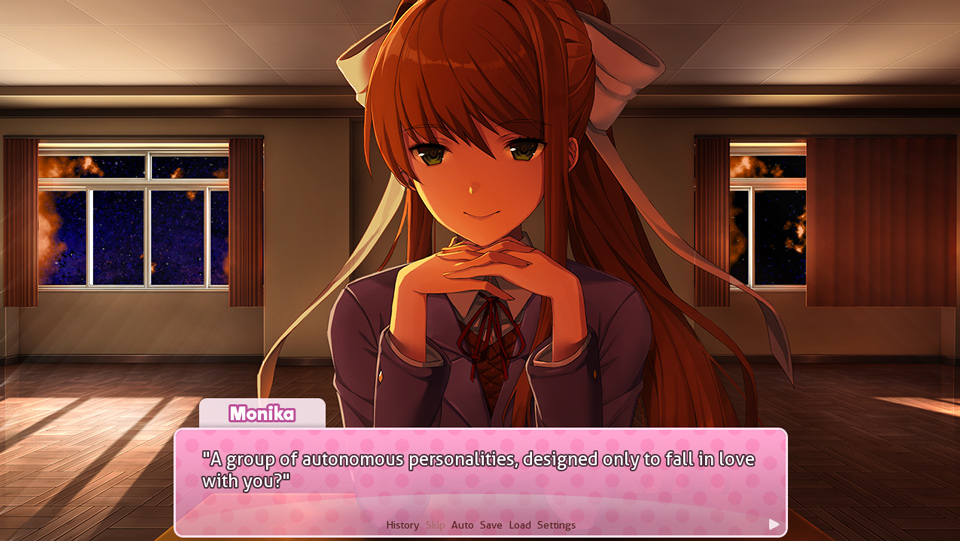
A little on the nose there, Monika.
Instead, the game turns Monika — arguably the only girl with any agency at all — into another trope altogether: “the obsessed stalker.” She traps you in the empty room, tells you she loves you, and forces you to choose yes when she asks you out. At this point, the game introduces a novel mechanic: you have to actually find and delete Monika’s character file in order to get out of the room.
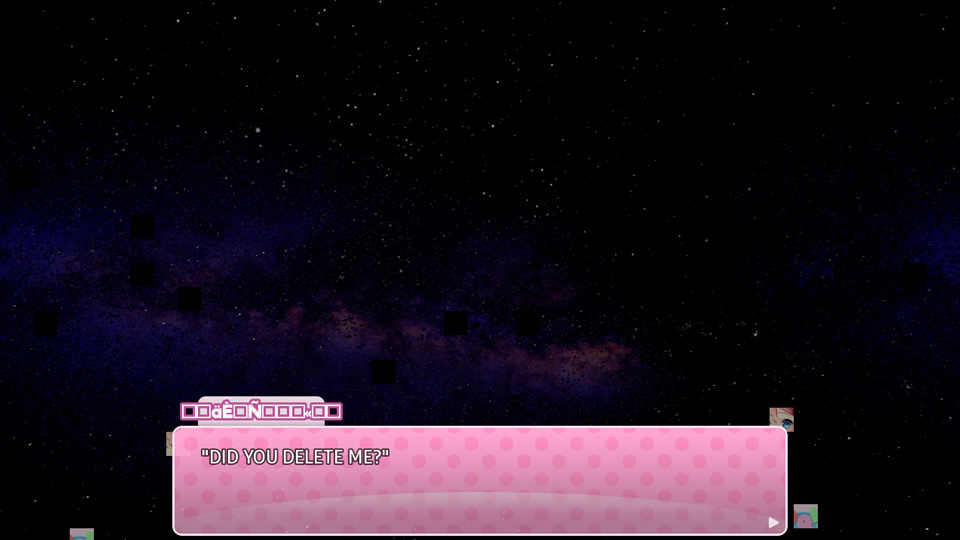
The game starts over again, this time without Monika, and it seems like everything will be fine. Before long, however, it’s revealed that Sayori, the new club president, is aware of everything that happened in the previous playthroughs. She goes full-Monika-crazy and tries to take you away to the empty room again, but actual Monika somehow intervenes. She realizes now that nothing good can come from the Literature Club, and deletes everything, ending the game for real.
As a horror game, DDLC definitely succeeds in delivering scares — a mix of a few startling moments, graphic images that are hard to forget, and a general and persisting sense of creepiness and despair. And the game is clever, sure, but ultimately I was left disappointed. Rather than simply acknowledging the ridiculous trope of no female agency in dating sims and attempting to explain it away from a meta perspective, I wish the game had instead just given the girls more agency. For an experience that was clearly designed to flip expectations, DDLC missed a huge opportunity and fell flat for me.
This Queer House, Vol 9: End of Year Mailbag
It’s December, which means another year is almost in the books. Here at This Queer House, we’ve had some ups (my dining room furniture looks great!) and some downs (one word: caulk).
To finish the year off strong, I took to twitter to answer your burning DIY questions.
Question one is from @mchodora, who writes, “I need help rewiring a lamp. Please!”
Let me tell you what, the idea of rewiring a lamp is a lot more daunting than doing the actual thing. I borrowed an old, out of order lamp from a neighbor, and the whole project took well under an hour. Here’s how I did it:
What You’ll Need:
- Lamp
- Rewiring Kit – I accidentally bought a lamp-making kit, which came with a whole bunch of parts I didn’t need. All you really need is a new cord and socket and you should be able to reuse the old hardware.
- Pliers – I like using needle nose, for dexterity.
- Wire cutters – Many pliers have built-in wire cutters, so be sure to check.
- Screwdriver
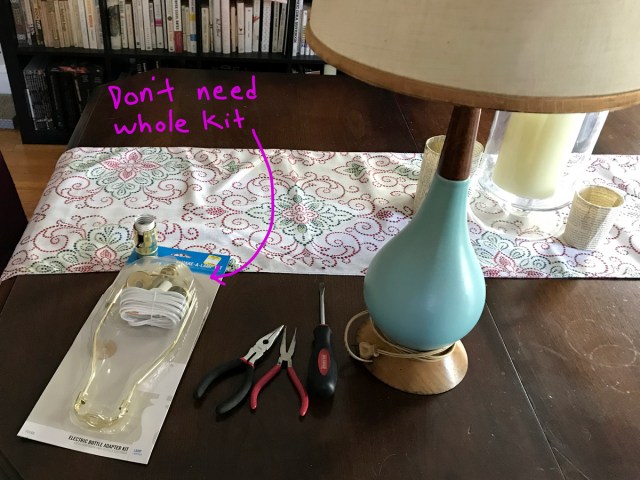
What To Do:
1. Take off the shade and remove the lightbulb. If it’s an older lamp, like the one I was working on, you might need to use some WD-40 and pliers to get the top cap off.
2. Remove the socket sheet and pull out the old socket. The socket sheet should just slide right off. I was able to pull the socket out of the socket cap easily, but you may need to use your screwdriver and gently pry it out.
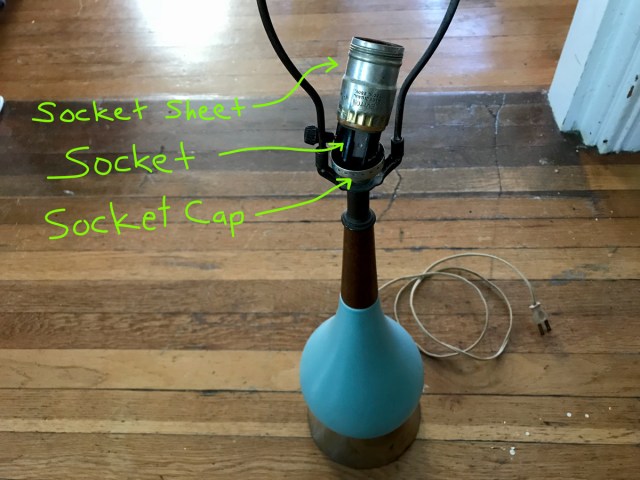
3. Cut the cord and remove it.
4. Thread the new cord through. My lamp was a bit tall and tricky to get the cord through, so I took it all apart.
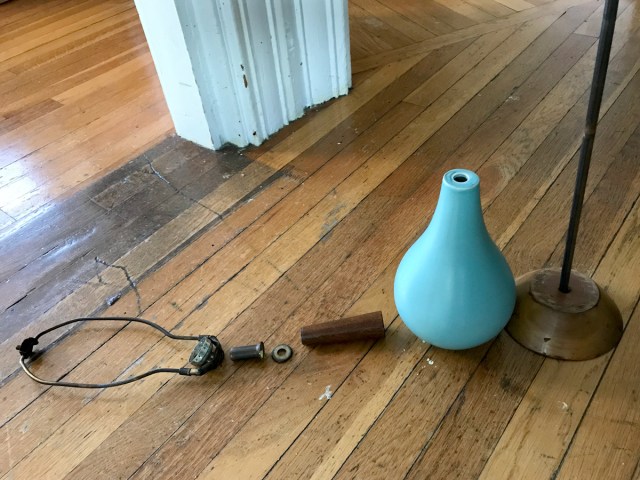
5. Reassemble the lamp (optional). If you took your lamp apart in step 4, now is the time to put it back together up to the socket cap.
6. Tie an underwriter’s knot with the cord extending out of the socket cap. I had absolutely no idea what this was, or how to do it, but I found a woman on YouTube who showed me how. She is lovely!
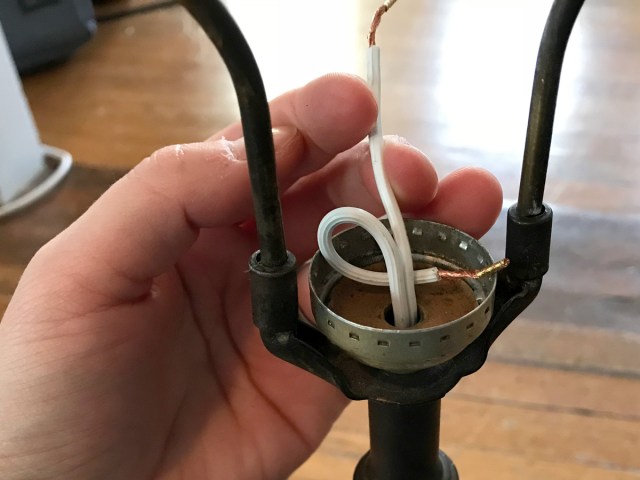
Halfway to an underwriter’s knot.
7. Identify the neutral conductor. Your kit should tell you which one it is. My kit claimed that one conductor had ribbing on the insulation, but tbh they both kind of looked ribbed. I asked my wife for a second opinion and she said, “Yeah, I think you’re probably right, but it’s a 50/50 chance anyway – just go for it.” Wise words when dealing with electrical work, indeed.
8. Connect the wires. Again, consult your kit here because they should tell you which wire should go to which screw. Loosen up the screws, wrap the conductors around, and then tighten the screws up.
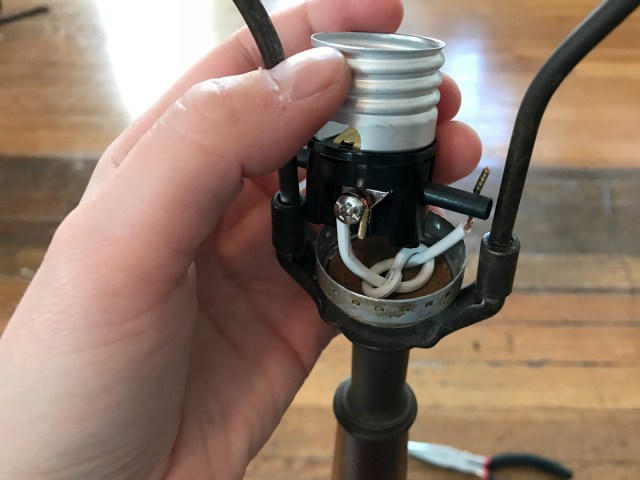
9. Push the socket into place and cover it with the socket sleeve. That’s it! All that’s left to do is grab a bulb and plug it in.
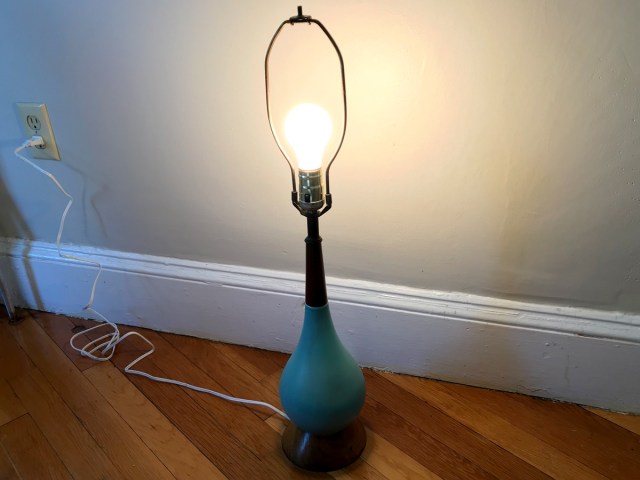
The next question comes from @33katiek: “Love this column! I’d also love to know how to replace moldy silicone between my vanity unit and the tile backsplash!”
Katie, just reading this question gave me intense flashbacks to a column I wrote a few months back where I replaced the caulk in my bathtub. Assuming what you need to do is similar to that, I’ll direct you there and let you learn from my mistakes.
Our final mailbag question, from @lucyhallowell, asks, “how do you stop a toilet from running?”
This actually happened to our toilet recently, and it wasn’t too difficult to get it to stop. Here are some possible fixes:
-
- Check the fill tube. If something is wrong with the connection of the fill tube, the tank might not properly fill up. Check to make sure the tube is firmly secured onto the fill valve and that it sticks up about an inch out of the overflow tube.
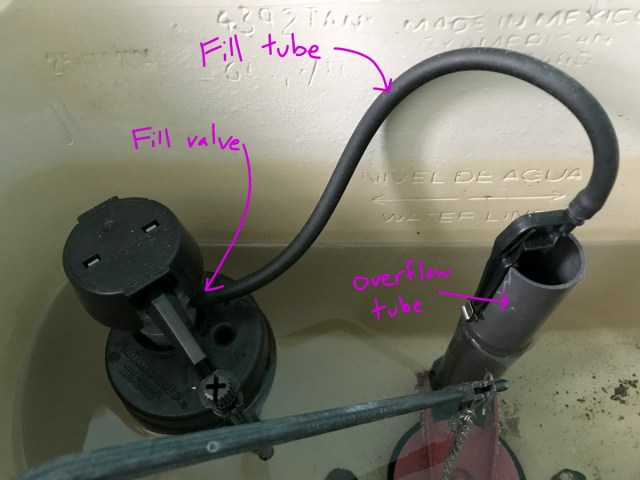
-
- Adjust the float. If your float is set too high, it could cause water to spill back into the overflow tube and make the toilet keep running. The float should be easily adjustable – look for a clip to squeeze.

-
- Check the flapper chain. Ideally, the chain should connect the flush rod (the piece that attaches to the actual handle on the outside) to the closed flapper (the red seal on the bottom of the tank) with just a little bit of slack.
- Replace the flapper. This is what we had to do to fix out toilet, which would run intermittently, and it seems to be a common issue. If the flapper doesn’t seal thoroughly, the water will leak through slowly and cause the toilet to run. We weren’t able to match the type of flapper exactly, but buying a universal replacement has done the trick. Flappers are easy to install – most snap right on.

Well that’s it for This Queer House in 2017. I’ll see you with more DIY tips/projects/lessons in 2018!
I Accidentally Punched The Virtual Reality Assistant Who Helped Me Become Wonder Woman and It Was So Worth It
All images via Warner Brothers
Up until a few months ago, whenever I heard the term virtual reality I only really thought of ’80s and ’90s sci-fi movies (like the terrible/great Keanu Reeves classic Johnny Mnemonic) or “Virtual Insanity” by Jamiroquai. The whole VR concept seemed too gimmicky, and I was skeptical about how immersive the experience could possibly be. I recently purchased my very own PSVR and can now officially say I’m a fan of virtual reality games.
How did I get here? Like so many of my nerdy stories, this one begins at a comic con — NYCC 2017, in this case. One of the most popular exhibits on the floor was a demo for Justice League VR: The Complete Experience. Even though the lines were long and the only member of Justice League I really care about is Wonder Woman, I figured it was as good a time as any to finally give VR a try. And, you guys, it’s so weird and different and fun!
For this particular demo set-up, I was lead to a private cubicle (probably around six or seven square feet) and assigned an employee to help guide me through the experience. I have no idea how much these assistants were paid, but I hope it was a lot because I put this poor woman through a lot in the short amount of time I was in her care. The woman helped me get the headset on, handed me a couple of controllers, and showed me how to start the experience. Each member of the Justice League has a separate mini-game, so obviously I chose Wonder Woman first.
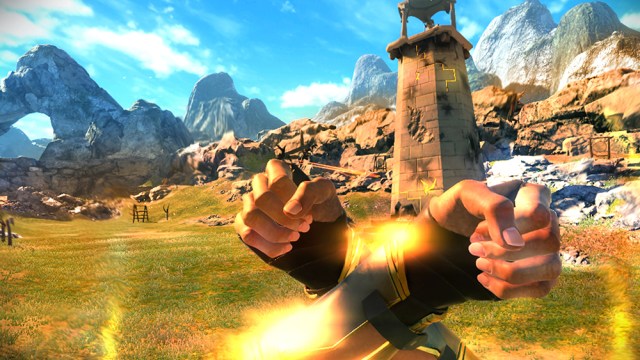
TIL these are called the “Bracelets of Submission,” so that’s pretty awesome
In Wonder Woman’s vignette you have to fight off Parademons, mainly with her sword and shield. To fight them you have to, essentially, wave the controllers around wildly. At least that’s the approach I took, but maybe it was the wrong one. Not only did I accidentally punch the wall which hurt, but I guess at least I didn’t break anything — I actually punched the employee who was helping me! Bless her heart, she took it in stride, but I felt terrible.
Other than the issues caused by my apparent Hulk-like aggression, the game was pretty neat. One of the best parts was actually just being able to turn and look all around Themiscyra as I fought, even though it was definitely a bit disorienting. My sense of balance and spatial perception didn’t get any better when I moved on to the next mini-game: Aquaman.

In this experience you swim through the ocean as you try to catch a sea monster, and the constant motion really threw me. I started leaning a lot and almost fell over because I could not get my bearings — but my guardian angel (who, remember, I had already accidentally assaulted) saved me again so I didn’t end up on the floor. Surprisingly, my favorite of the three demos I tested was Batman’s. I’m not sure if it was because I didn’t fall over or punch anyone/anything, or possibly just because I really like driving/shooting games — you decide!
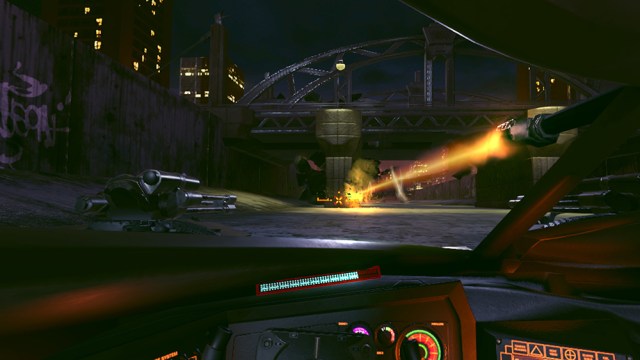
Just *slightly* different than Mario Kart
Overall, Justice League VR: The Complete Experience was a really fun little intro into the world of VR for me. The game is available on a whole slew of systems for about $10. It doesn’t seem like there is much expanded gameplay beyond the demos from NYCC, though, so I wouldn’t bank on much replay value.
After my semi-successful first VR experience, I was itching to try something else. Something seated and non-violent, perhaps. Luckily for me/unluckily for my bank account, I found out that PSVRs are essentially half off through Christmas Eve and I figured, fuck it. I’ve only had it for a few days, but I’m very satisfied with my purchase so far. The headset is actually more comfortable than I expected it to be and the game that came with my bundle, Gran Turismo Sport, is fun and way less stressful than all the other games I’ve been playing lately.

Yes, I keep crashing my car to look around at the scenery.
If you’re not willing to invest in such a costly VR purchase just yet, have no fear! VR bars, cafes, and arcades are springing up in many cities (like DC and Brooklyn). They provide an alternative to the big one-time cost of owning your own system, but just be aware that they tend to be expensive in their own right. VR Bar, the arcade in Brooklyn, charges $14 for 15 minutes of gametime — you could own your very own PSVR for the price of like three and a half hours at the arcade!
I am well aware that a lot of the appeal of virtual reality, for me at least, is the novelty factor. Gran Turismo Sport isn’t the best driving game I’ve ever played, but damn if I don’t get excited to gaze up at the clouds when I’m cruising around in a convertible.I’m really interested to see how the technology might continue to improve in the next few years — hopefully we’ll see even more immersive experiences. I will be sure to stay away from any combat games for the foreseeable future, though. As I learned at NYCC, I’m a menace in the VR world.
Cambridge, MA 12/9: Holigay Meet-Up: Day Drinking and Games!
Venue: People’s Republik
878 Massachusetts Ave
Cambridge, MA
02139
United States
Event Date: December 9, 2017
Start Time: 2:00 pm
End Time: N/A
Host: Dufrau and Jenna
Description: Wear flannel, drink beers, be friends, show us pictures of your pets.
RSVP: No RSVP needed – just show up!
“Steven Universe: Save the Light” Is a Warm Blanket in a Cold World
If you’ve never seen Steven Universe, allow me to take a moment and explain why the choices you’ve made up until this moment in your life are all wrong. Sorry, that was a little aggressive, but Steven Universe is perfect. Mey has written a lot about how important and queer it is, and her pieces includes lots of background information and a great overview. I only started watching Steven within the past year, and it has become a warm and snug security blanket that helps shield me from a world that feels increasingly colder. It’s an earnest, silly look at friendship and family, love and heartbreak — and also snack foods.
When a friend told me a Steven Universe RPG was coming out on PS4, I immediately knew I had to play it. This game, Save the Light, is actually a follow up to a 2015 mobile game called Steven Universe: Attack the Light! The structures are really similar, both are single-player RPGs with turn-based battles, but the newer version is longer and deeper. You don’t need to play the mobile game first, as Save the Light recaps the events from its predecessor in the first few scenes, but my wife says it’s fun and it’s also only $3 on both iOS and Android.
Despite some technical issues, which I’ll get into later, I’m absolutely loving Steven Universe: Save the Light. It feels exactly like I’m watching an extended episode of the show, and, as a bonus, I get to participate and interact with all of my faves. Speaking of faves, all of the voice actors signed on to record the game, so the characters are pitch perfect. And Rebecca Sugar herself was involved in the writing. Steven is enthusiastic about everything, Garnet is just the coolest, Pearl is all about strict order and rule-following (but with hints every now and then at how she has the tenderest heart in the universe and I LOVE HER, OK?). Everyone is just right. The newest gem to be introduced, Christine Baranski playing an over the top homeworld villain named Hessonite, is delightfully evil and a great addition to the cast.
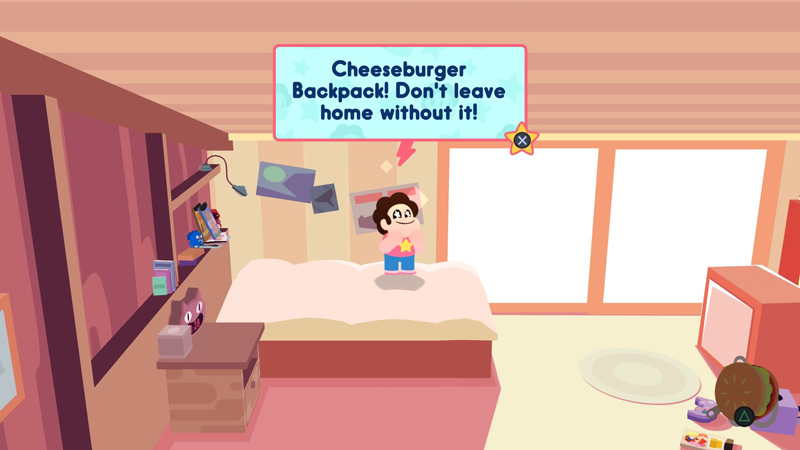
Everythings is so good! Right down to the stars in Steven’s eyes!
It’s not just the characters that make you feel like you’re in the show; there was clearly a great amount of care taken to replicate details, both small and large, when creating the worlds you can explore. Beach City is full of familiar faces and places, Bismuth’s Forge is dark and mysterious, the Strawberry Battlefield is broken, but somehow serene — each world is beautiful with lots of individual character. One small issue I’ve had is that because I play a lot of games where I’m able to control the camera angle, I don’t love that there’s a fixed camera in this game. I wanted to be able to peer around corners or scan what was coming next, but the camera doesn’t move until you inch forward.
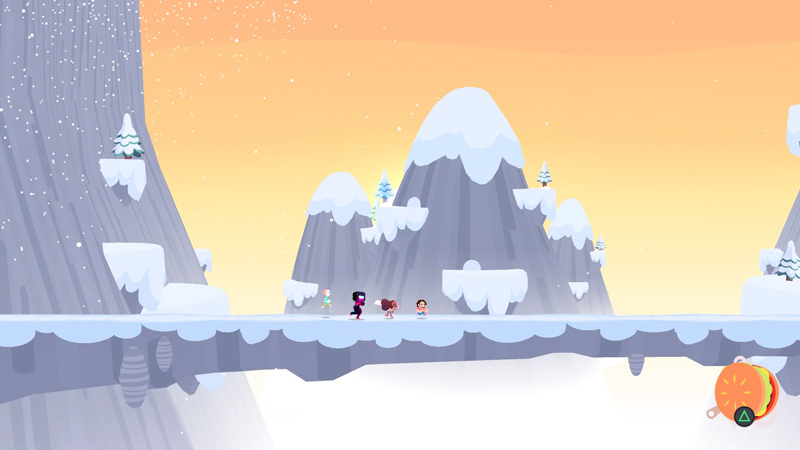
This is just one of many gorgeous settings
I’ve gotten used to the fixed camera the more I’ve played, so it only bothers me now when I notice the transition isn’t quite as smooth as it could be (one of the more minor technical issues I’ve found). The worlds are huge (and easy to get turned around in) with lots of paths to explore, stuff to find, and battles to fight. Unfortunately, the game doesn’t always seem to remember where you’ve been and what you’ve completed. I’ve had to re-fight enemies to clear areas multiple times, and it can get a little annoying.
Even when I completed enough of a world to unlock the next, the game still let me know I had only finished a percentage of the things I could do — they ranged from single digit up to about 65%. I’ve already put around ten hours or so into the game and I’m only about a quarter of the way through, so it’s definitely not lacking in gameplay length.
I am experiencing so many little moments of joy at nearly every turn as I play this game. For example, I didn’t expect to giggle to myself at a simple character upgrade screen (the place where you can assign points to different skills like attack, defense, or teamwork). I did just that, however, when Steven sang a little song (“RPG, RPG! It’s a quest for you and me!”) or when Garnet simply offered a deadpan, “Hello” right after.
The collectable items, which you can use in and out of battle to increase skills or health stats, are also themed for the show and have perfectly Steven descriptions:

Hooray!
And anyone who is a fan of the show will be happy to know that you can acquire those frozen treats with an all new taste, Cookie Cat.
The battle mechanics in Save the Light are pretty straightforward. Every character has different moves they can perform in battle, each worth varying amounts of star points. When the star points run out, the party has to wait for the meter to reset and the points to be replenished before they can attack again (unless they have an item that allows them to skip the wait). As characters level up, they unlock better attacks and skills, but the enemies become more difficult as well.
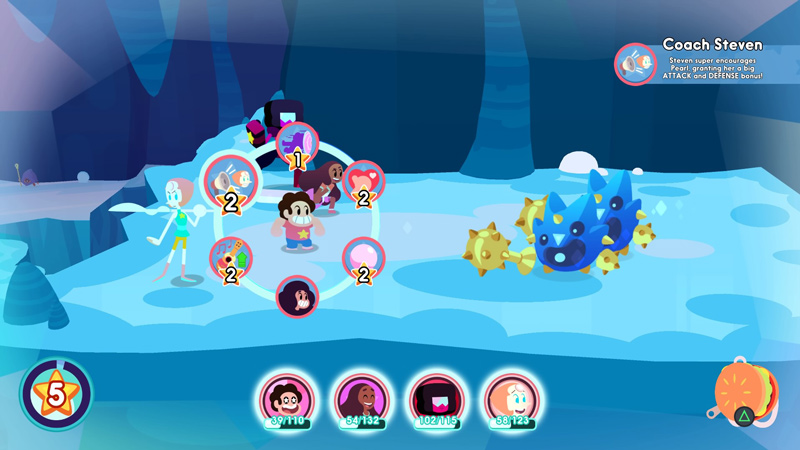
Steven’s battle options
Battles are generally fun and engaging, but can become a bit repetitive, especially if you have to re-play them or if you’re on the cusp of leveling up and have had the same attacks for quite a while. As the battles get more challenging, there’s definitely an increase in the level of strategy involved that I found to be really satisfying. I had to think through the strengths and weaknesses of my party members, and figure out how best to utilize them all.
Just like on the show, friendship and teamwork are main themes of Steven Universe: Save the Light, and I loved every second of it. You build up relationship points by having party members compliment, protect, or help one another. When you fill the relationship meter up, it opens up special attacks and skills that the characters can perform together. If you fill up the relationship meter between two gems (or Steven and Connie), you can form a fusion with awesome new attack possibilities. I think the Stevonnie attack is the only reason I beat at least one of the bosses.
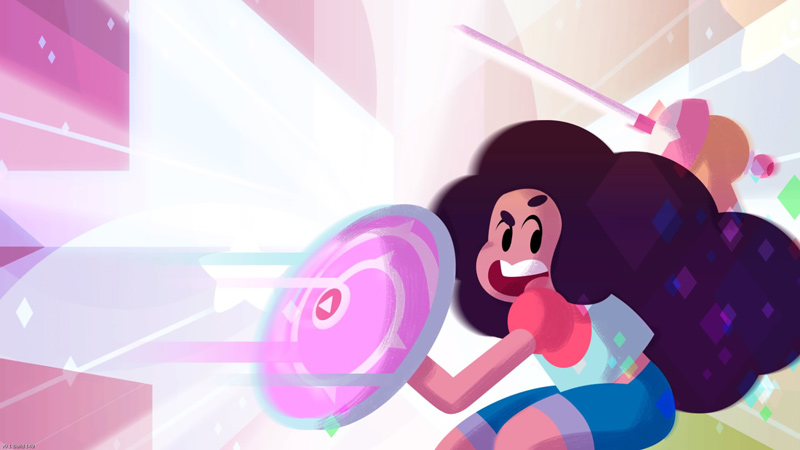
Non-binary hearteyes for days
Which brings me to the only bummer of the game: technical bugs. (Womp womp.) They ranged from minor glitches that didn’t impact my gameplay to actually having to restart my PS4 in the middle of a boss battle. So far, I’ve had to quit the game a handful of times because of these bugs — the most hilarious of which happened when Peridot fell into a spike pit on a loop and yelled “Clod!” over and over again.

Got to at least 20 “clods” before I restarted
Luckily, the autosave functionality is decent and I haven’t lost more than about 15 minutes or so of progress at any given time. The studio, Grumpyface, seems to be aware of the issues. They’ve already released one patch and, hopefully, more are on the way.
Overall, if you’re a fan of the show you will probably love this game. It captures all the charm of the Steven Universe… universe, while immersing you in a new and engaging story. I’d maybe recommend waiting to see if more patches are released before buying, though, and in the meantime you can enjoy the mobile game first.
Steven Universe: Save the Light is available on PS4 and Xbox One.
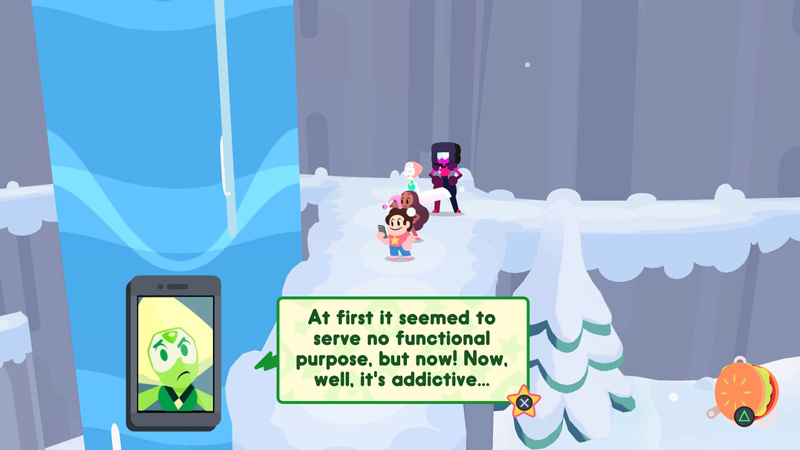
Wow, call out post.
This Queer House, Vol 8: Baby, It’s Cold Outside
Winter in New England can be magical: crisp days full of fresh snowfall, and nights spent cuddled under a cozy blanket. I love it all. (Well, I love it for at least the first few months. Ask me again in March.) Something that’s not so awesome about New England winters, however, is paying your heating bill. Living in a drafty old apartment can be especially frustrating, because you’re spending money to heat up air for it to just escape outside. In this month’s This Queer House, I’ll show you how to get your home ready for winter by keeping the warm air in and the cold air out with a DIY draft stopper, as well as a few other helpful tips.
What you’ll need:
- Fabric – One yard of fabric will be more than enough to make a draft stopper. Depending on the size of your door or window, you can probably get about three stoppers out of one yard of fabric.
- Sewing machine/supplies – I guess if you don’t have a sewing machine you could try to hand sew the entire thing, but I wouldn’t recommend it.
- Needle and thread – You will definitely need to hand sew a small opening to finish the stopper.
- Measuring tape/marker/scissors
- Recycled newspaper cat litter – I used a brand called “Yesterday’s News” because that’s what Martha Stewart told me to do and I always listen to Martha.
What to do:
1. Measure your doorway or window. The most common door width is 32″, and that’s what all my doors are, but you should measure to check yours.
2. Cut your fabric. You need a rectangle of fabric that’s the width of your door/window + 1″ on either side by a length of 9 ¼”. So if your door is 32″, cut a piece of fabric that’s 34″ x 9 ¼”.
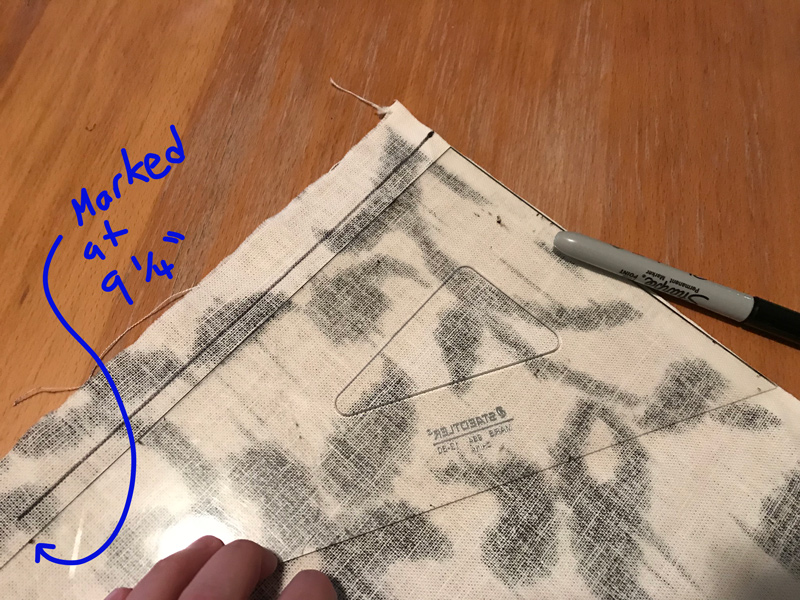
I use a triangle and mark the measured length on it- that way my corners end up square.
3. Sew the edges. Fold the fabric in half lengthwise (with the less pretty side of the fabric facing out) and sew it around the edge. Make sure to leave a small gap (2-3″) on the long side so you can turn the whole thing right-side in and fill it up. I haven’t used a sewing machine since I made a kangaroo costume in 6th grade, so my wife helped me out with this step.
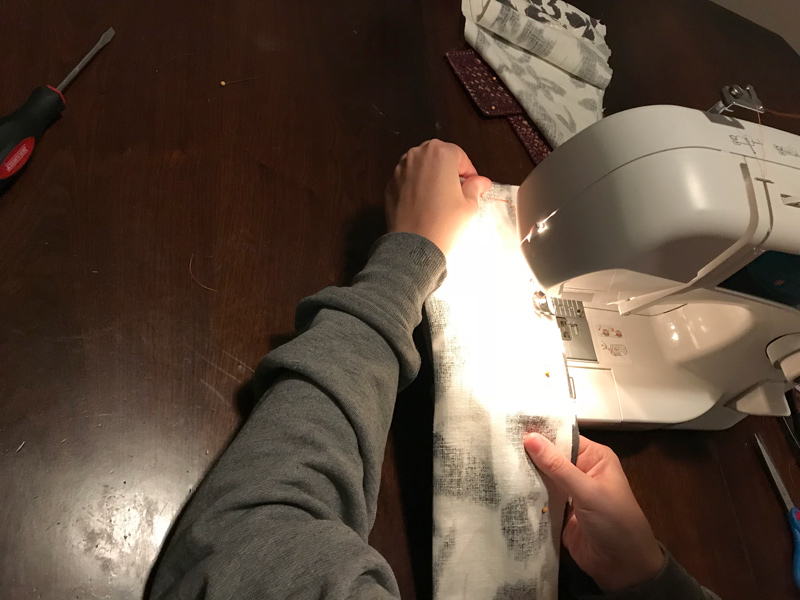
My wife is the hero I need, but don’t deserve.
4. Fill it up. I made a quick funnel out of paper and tape to make this process a little easier. You want to fill the draft stopper up, but don’t overfill it so much that it’s totally stiff.
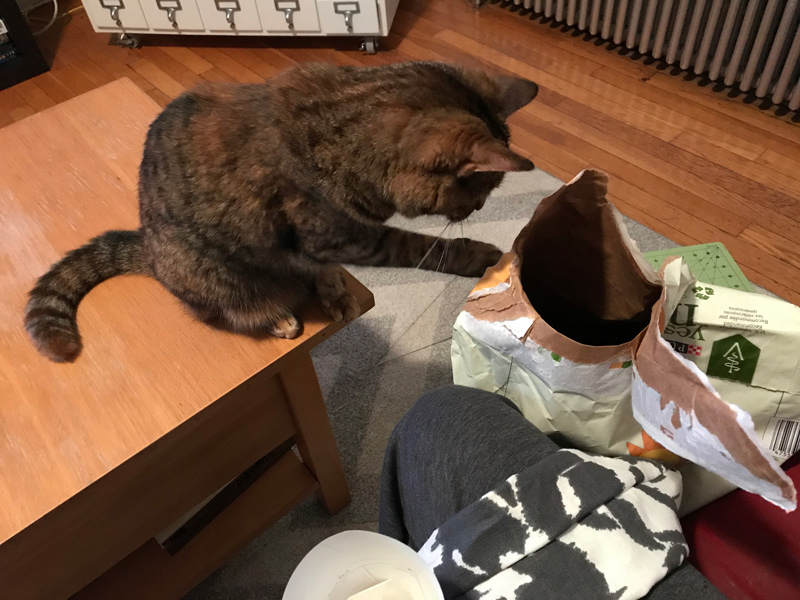
Flapjack was less than helpful during this, but, to be fair to her, I was basically playing with kitty litter right in front of her.
5. Hand sew the opening. I’m not the best seamstress, but you don’t have to use a pretty stitch – just get the job done.
6. Stop those drafts! Use a draft stopper anywhere you notice cold air leaking under a closed door or window.

More winterizing tips
Other ways to seal drafts – The most simple way to keep warm air in your home is to keep your blinds or curtains closed – especially if they aren’t on windows that get direct sunlight. You can also check for drafts around the edges or your windows and seal any gaps you find with exterior caulk. (See here for more info on caulk, and also I hope you’re better at using it than me.)
You can also seal your windows with an insulation kit, which essentially means you cover them in plastic wrap. Unfortunately, my cat weirdly loves to chew on plastic, so this doesn’t always go well or last very long in my house. One thing I really do like about the window insulation kits I have bought is the Frost King logo.

Look at this lil buddy!
Check your heating – Make sure the heat is actually working well. If you have a hot water radiator, check that the entire thing is giving off the same amount of heat. If one side is getting hot, but one side is staying cool, you might have to bleed your radiator. You can do this by taking a radiator key (or just a flathead screwdriver, depending on the valve) and slowly turning it counterclockwise. You’ll hear a rushing sound, which is good – you want to release the trapped air. Once water starts to drip out, you can close the valve. Your radiator should work fine after that.

Hot water radiator valve + key
I hope these tips help keep you warm in the coming months. As always, please share any other techniques you may have picked up over the years in the comments.
Please let me know if you have any DIY related questions or projects that you would like me to answer or address in next month’s column. You can leave those in the comments here or hit me up on twitter (@jennalykes) or email (jenna@autostraddle.com).
“Life Is Strange: Before The Storm” Episode 2 Will Pummel Your Gay Heart in the Tenderest Way
Pretty aggressive spoilers for both Life is Strange: Before the Storm and Life is Strange below. If you’re planning to play, please do so before reading or I won’t be able to live with myself.
When I first heard the E3 announcement about Life is Strange: Before the Storm, I was hit with a wave of anxiety. I was obviously going to play no matter what, but I worried the game would feel like a cheap gimmick at best, and at worst would ruin my memories of the original Life is Strange. Knowing what we know about how things turn out for these characters, I wondered what kind of story would be left to tell? The answer, as it turns out, is actually kind of my story – and maybe it’s your story, too. Episode two, Brave New World, is a beautiful fever dream; it’s a gift to queer gamers, an eerily accurate depiction of what it’s like to be a teenage girl just starting to figure out that, hey, maybe you like girls.
Brave New World begins hot off the events of episode one, with Chloe and Rachel and their parents in Principal Wells’ office for a disciplinary meeting. But they’re not in trouble for starting an actual forest fire, which is definitely the worst secret thing they’ve done so far, they’re being reprimanded for ditching school.
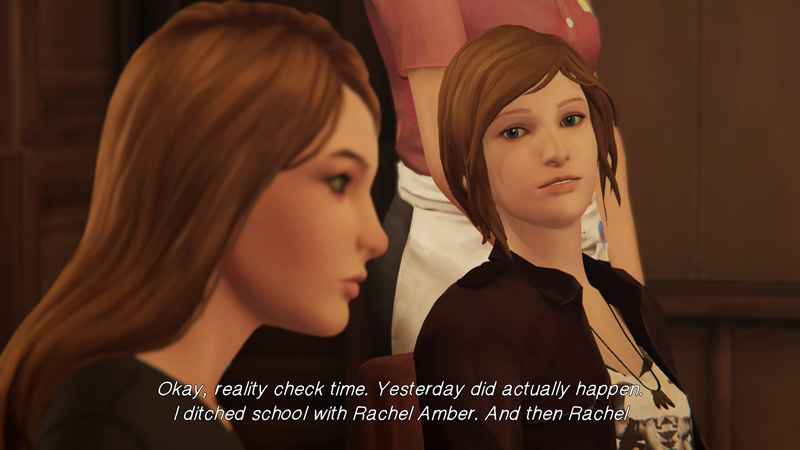
I also need a reality check. Lots of them.
Wells condemns Chloe, on account of how she’s a repeat offender, and is ready to punish her until Rachel speaks up to take the blame for their truancy. Only about five minutes into the game, and I’m already deep in my feelings because Chloe just looks so damn surprised that Rachel is trying to cover for her. Has anyone stuck up for her since her dad died? Since her best friend left? She looks at Rachel like she can’t believe anyone would risk themselves to protect her.
With this new information, Wells issues a punishment: Rachel won’t be allowed to perform in the school play, The Tempest. But Chloe knows how much the play means to Rachel, so she tells Wells exactly what he wants to hear. She says skipping school was all her fault and, because she’s Chloe, she does it by yelling insults in his face. And it’s not a surprise if you’ve played Life is Strange, but now we know exactly how Chloe was expelled from Blackwell.
As Chloe is cleaning out her locker, she comes across a photo of her rescue cat, Bongo, who got hit by a car and died. The moral of the story, Chloe bleakly reminds herself, is that “no one’s ever really rescued.” She’s certainly not expecting Max to come and save her — the girl hasn’t even responded to one of Chloe’s texts in months.

R.I.P. Bongo
When I was 13, one of my best (and only) friends gave me half of a friendship necklace and a promise that this wasn’t a forever goodbye, and then she moved away to Alabama. After a few months, she stopped writing back too. For me, it was letters instead of text messages, but I still haven’t forgotten that searing sting of abandonment. Chloe has been broken in so many ways, but she has no idea how to even begin to handle all the cracks. She just leaves them gaping and exposed, and she hurts and she hurts and she hurts.
After fighting with her mom and David in the school parking lot, Chloe heads for the only safe place she has left: the junkyard. Finding Chloe’s future truck there for the first time felt a bit like seeing an old friend, and it’s just one of many nods to the original game. As she’s wandering around looking for ways to fix up the truck, Chloe stumbles on a nudie magazine. Her reaction to it, like one of her earlier journal entries about how “Pris from Blade Runner popped into [her] head last time [she] rubbed one” are just a couple of small, but welcome, details that show us Chloe’s uncertainty about her sexuality.

“Weird.” Okay.
Chloe fixes up the truck to the best of her ability before enjoying a smoke break, which is set beautifully to “A Hole in the Earth” by Daughter. The Life is Strange soundtracks have always been phenomenal, and this episode is no exception.
Rachel shows up at the junkyard to flirt a little and also talk about feelings a lot, and the whole scene is just so queer and so authentic. Even though Chloe and Rachel only really met a day ago, it doesn’t feel like their relationship is progressing too fast at all. There’s this thing that’s always happened to me, I call it making “summer camp friends,” where I strike up a very intense, very immediate bond with another person. The women (so far they’ve only been women) are all either queer or questioning, and the friendship always sparks like Alison’s “Ring of Keys” moment in Fun Home.
Chloe and Rachel obviously have this same kind of spark — they can feel their hearts saying “hi” — but up until now they’ve mostly danced around it. They get closer to acknowledging it than ever before during their impromptu therapy session; Rachel puts her head on Chloe’s shoulder, and Chloe looks surprised and terrified and happy all at once. It’s a lot to handle.
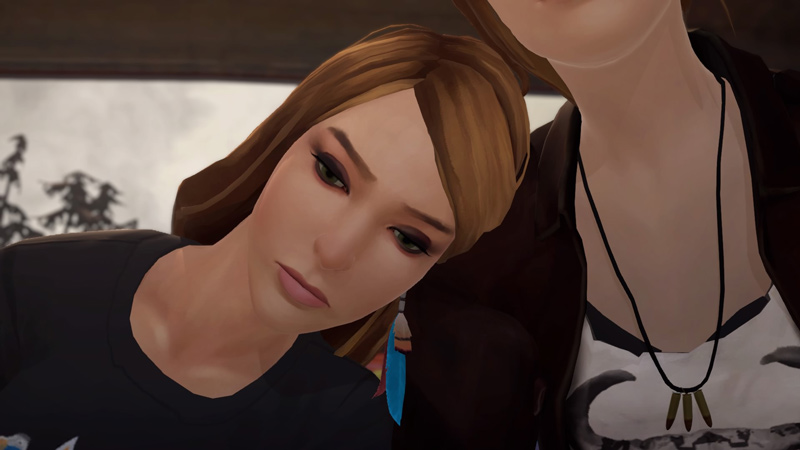
R.I.P. ME
A little later on, there’s yet another beautifully realistic conversation that almost could’ve been lifted directly out of my life. Steph, who is also queer and totally out at Blackwell, asks Chloe if she and Rachel are together. Chloe panics and stutters out her response, telling Steph that she doesn’t know and it’s confusing. And Steph, of course, immediately gets it, because my experience has been that queers can usually recognize queers.
The first person I ever came out to was a “summer camp friend” I had just met the day before. We rode the T around Boston all night, talking about everything. We walked through Chestnut Hill as the sun was rising and made up stories about the rich people were just getting out of bed. She told me she was bi so bluntly, she just knew exactly who she was, and I was in awe. I stumbled, I couldn’t say anything back, but she knew anyway. She asked if I was straight, probably because she thought it would be easier for me to say no to that first. It was, and I did.
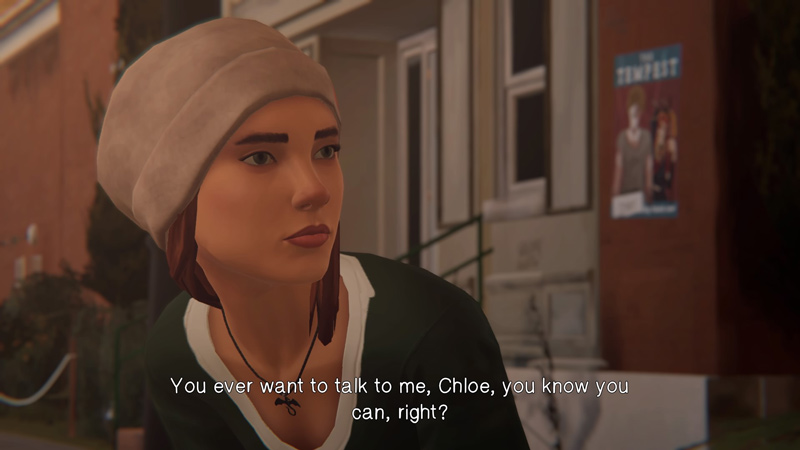
Everyone needs a Steph
At the beginning of this, I called Brave New World a beautiful fever dream, and the scenes before, after, and during the performance of The Tempest are really the dreamiest part of the whole game. The cast is down a couple of actress and there is no one to play Ariel, so Rachel volunteers Chloe for the role. Chloe, obviously, wants nothing to do with it. But then Rachel pleads with her, asks Chloe to do it “for me,” and there’s a really great transition from Chloe just sighing, that then cuts immediately to her in full Ariel costume.
The performance starts out fine, but turns into a downright ethereal vision when Rachel goes off script. Instead of assuring Ariel’s freedom, which is the written line, Rachel says that she cannot stand to let Ariel go because she holds her too dear. Chloe improvises admirably (and adorably), and the two talk about their feelings on a hazy stage under the guise of Shakespearian prose. Rachel drops to her knees and promises Chloe that she cares for her and that they will run away together as soon as they can, an echo from their earlier conversations. The scene becomes even more meaningful when you realize, as my wife pointed out, that in The Tempest, Chloe’s character of Ariel is at times only visible to Rachel’s Prospero. Only Rachel can really see Chloe.
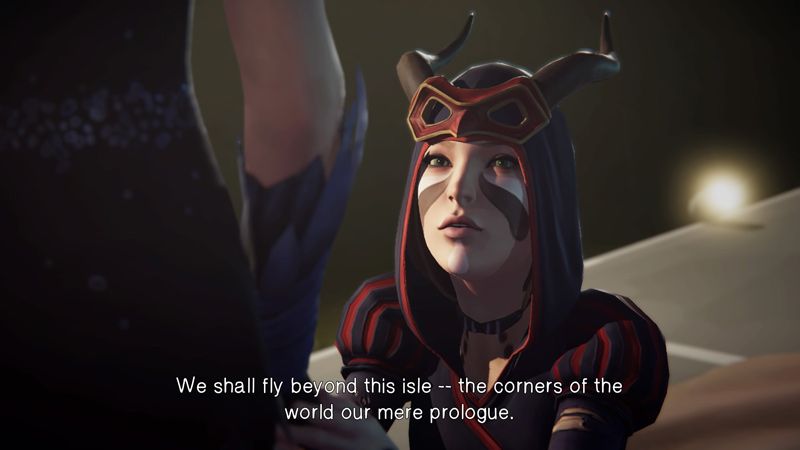
Just fuck me up.
On a post-performance high, Rachel and Chloe practically float through the neighborhood and make more big plans for their Arcadia Bay getaway. They hold hands and spin and talk about the future, and it finally becomes too much for Chloe to pretend. She’s feeling things she’s never felt before and she’s terrified that it’s not the same for Rachel, so she asks if Rachel really means it. Rachel says she’s more serious than she’s ever been, and wants to know what it would take to convince Chloe.

I need to confess something. I, a known queer, almost did not choose the kiss option. The lack of rewind in Before the Storm has made me second guess every single decision, and I was scared that Rachel would say no or it would somehow backfire. I am so glad I went for it, though, because I was rewarded with the most tender video game scene I have ever played in my whole entire life. Chloe can’t bring herself to ask for a kiss, she can’t say those words out loud, but she manages to shift and mumble adorably and awkwardly enough so that Rachel understands.

The first time I kissed my wife, almost 12 years ago, I didn’t know how to ask for it either. It’s hard to verbalize something that big, something that scares and excites you beyond a measure you’ve ever known before. Luckily for me, my wife understood my non-verbal “moves” too. When we kissed, I felt like something switched on inside my sternum, and somehow this video game and this character capture that feeling perfectly.
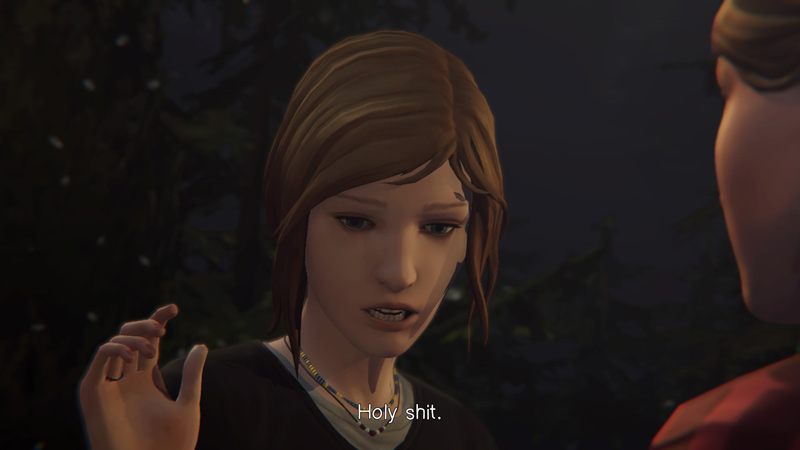
Same, Chloe.
I don’t know exactly what’s going to happen in the final episode of Before the Storm, but we all know how things end for Rachel so I’m bracing for impact. I hope the game doesn’t ever explicitly introduce Jefferson or any of the ugliness that follows; I want this game to stay separate from all that. No matter what, I will forever cherish the three hours I spent playing Brave New World. I have never felt so seen by video game, and I don’t think I ever will again. In conclusion, Bae over Bay. Forever.
Life is Strange: Before the Storm is available on Windows, PS4, and Xbox One, and you should go play it (again) right this very second. Then you should listen to the cover of “Nineteen” by Hayley Williams on Tegan and Sara’s “The Con X: Covers” and cry about it with me.
This Queer House, Vol 7: Halloween Decorations on a Budget
Halloween is my wife’s favorite holiday. Some people get excited about Christmas carols or lighting the menorah, but Steph’s eyes light up at the mention of a psychological thriller movie marathon. Things get pretty festive in our apartment around this time of year, is what I’m saying. Instead of spending all our money at the local Target Booporium™, I decided to branch out from my usual semi-practical This Queer House tutorials and create a few DIY Halloween decorations on a budget. Get ready to get spooky.
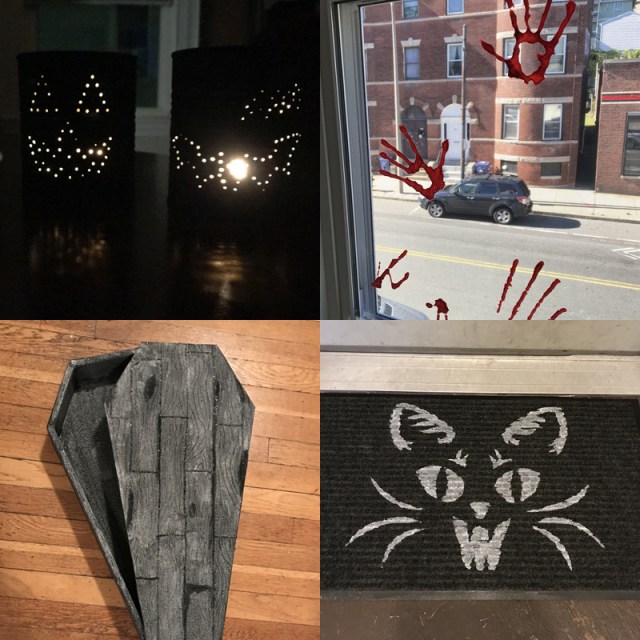
Clockwise from top left: Halloween-themed Luminaries, Bloody Handprint Window Clings, Seasonal Stenciled Doormat, Mini-foam Coffin
Project #1: Halloween-themed Luminaries
What You Need
- Empty, clean cans in any size
- Something sharp — I happen to have an awl, but you could use a hammer and nail in a pinch
- Black marker
- Black paint
- Tea lights
What To Do
1. Draw your design. I made one jack-o-lantern and one with a few bats on it. Because you’re going to be punching holes, bigger designs end up looking better. My smaller bat ended up just kind of looking like a blob.
2. Punch some holes. Because my tool was very sharp, it wasn’t too difficult to just push it through the can. If you’re using a hammer and nail and find that it is denting the can, you can first fill the can with water and freeze it.
3. Paint the can. I think black is best (as it provides the most contrast), but feel free to use whatever color you want. You might have to re-poke some holes if the paint fills them in.
4. Would you light my candle? Luckily, I happen to have literal hundreds of tea lights because I convinced my wife I just really needed them when we were at Ikea several years ago.
The Cost
Dollar amount: Only like $3 on cheap black washable paint. (In retrospect, I probably should’ve sprung for some better quality stuff though.)
Time and emotional amount: Not bad! Less than an hour to draw my designs and punch the holes. Dealing with the crappy paint did take a small emotional toll on me, however, and I might get new paint eventually to finish them.
Project #2: Bloody Handprint Window Clings
What You Need
- Elmer’s Glue
- Food coloring (lots of red and a little bit of blue)
- Cling wrap
- Scotch tape
- Heat gun (optional)
What To Do
1. Spread out the cling wrap and tape it down. Protip: pick a spot that’s out of the way for set up. That way you can leave the project alone to dry for as long as you need to.
2. Mix up your blood-glue. I poured food coloring directly into the Elmer’s bottle, because it seemed like less to clean up and also easier to apply. (And it was!) I used almost a full container of red food coloring and 3-4 drops of blue for about 3.5 oz of glue.
3. Make handprints/splatters. I applied the blood-glue to my hand to make some rough prints, but then applied more directly from the bottle to make sure they were thick enough. Also, they tend to shrink a bit as they dry, so it’s best to make things a little bigger than actual size.
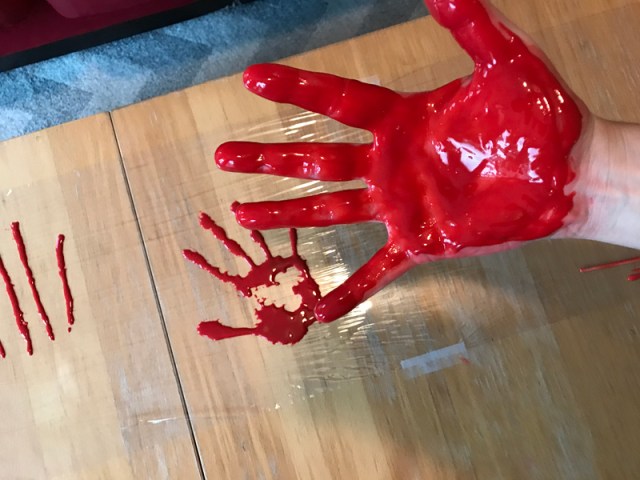
My hands were red for quite a while after this, use gloves if you’re not into that.
4. Let it dry. This took way longer than I expected (about 2 whole days). We ended up moving the whole piece of cling wrap to another room because we wanted to use our living room table, which, as you’ll see in step 5, was a mistake.
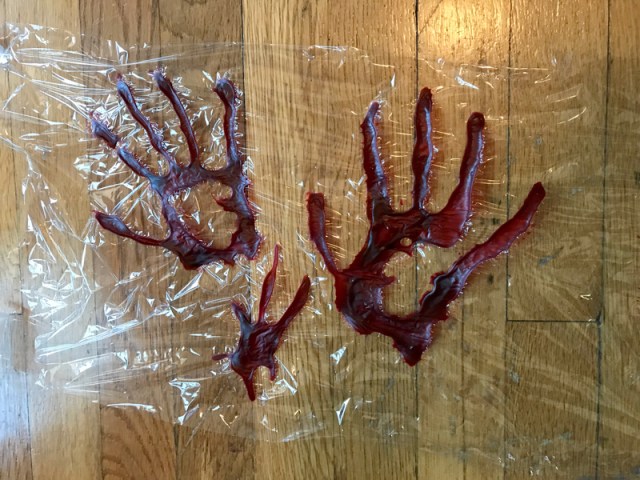
Very crinkly handprints
5. Apply to windows. The handprints and splatters came off the cling wrap really easily, but I had a tough time getting them to stick on my windows. I think that they tightened up and dried wrong because we moved the cling wrap.
I figured heat would help them stick, so I tried a regular hair dryer at first and that didn’t do anything but frustrate me. It never quite got hot enough, but it also blew too much air even on the lowest setting. I was about to throw in the towel when I remembered that I convinced my wife we needed a heat gun when we were working on our wedding crafts. (Are you seeing a theme here?) The heat gun worked perfectly, but I did burn my fingers a little.
The Cost
Dollar amount: 0$! I had everything for this project around the house already.
Time and emotional amount: Between the actual time it took for the blood-glue to dry and the angst and physical pain when I tried to stick handprints to the window, this project felt like more trouble than it was worth.
Project #3: Seasonal Stenciled Doormat
What You Need
- Plain doormat
- Fabric paint of some kind and brush
- Stencil OR supplies to make your own stencil (poster board, blade, cutting mat, pencil/marker, ruler)
- Scotch tape
What To Do
1. Get your stencil ready. If you’re using a pre-made stencil, you’re done with step 1! Congrats! If not, make one now. I printed out a very scary vampire cat and then drew a grid to make it easier to scale up. Once I sketched out the design, I cut it out with my blade.

Look at this terrifying kitten!
2. Tape the stencil to the doormat.
3. Paint it. This is where things went awry for me. I bought spray fabric paint, because I figured it would be super easy and quick. Reader, it was not. First of all, the can ran out of paint in about 20 seconds. The paint that did come out did not show up on the dark fabric at all. This was a failure.
4. Paint it, take two. This time I used regular fabric paint and a brush, and it worked a lot better. My doormat has textured grooves in it, which I didn’t think would matter for spray paint, but turned into an annoyance when using a brush. But I persevered, don’t worry.
5. Proudly display.
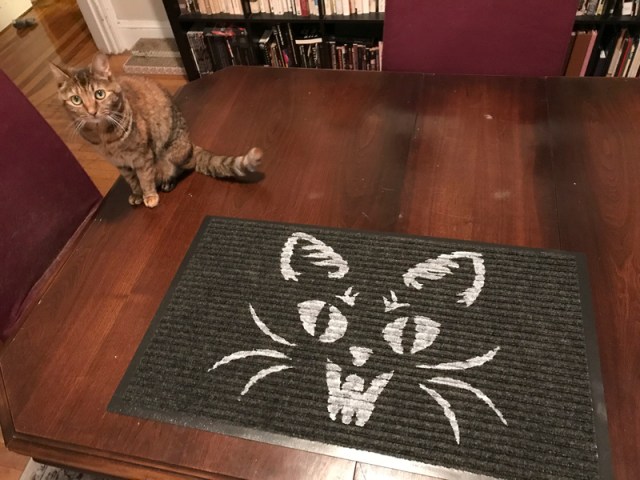
Actual cat not impressed.
The Cost
Dollar amount: The most expensive project of the bunch for me because of the paint mishap, but you could do it for around $12 or so.
Time and emotional amount: Altogether, probably about 2 hours to make the stencil and paint. Some emotional stress because of the spray paint, but overall — not unenjoyable!
Project #4: Mini-foam Coffin
What You Need
- Foam — I got it at a craft store, but you could also hit up a hardware store and it would probably be cheaper
- Blade
- Ruler
- Duct Tape
- Screwdriver or other blunt instrument to create texture
What To Do
1. Measure and cut your foam. I first measured and cut the top piece to look like the coffin shape I wanted. Then I traced that to create the bottom and measured out the sides by holding pieces up to each edge of the top. It was very scientific.
2. Assemble bottom and sides. The Duct Tape is easy to work with and it’s actually a forgiving fastener, so it’s not too hard to hide mistakes if you didn’t cut everything perfectly straight. I did have to trim some of the corners in order to get them to fit properly, but I just carved away a little at a time until things fit.

I’m a carpenter, basically.
3. Add wood texture to the lid. I used the screwdriver to dig into the foam and create the illusion of wooden boards.
4. Paint it. The crappy quality paint actually worked pretty well on this because it ended up looking like a gray wash on the whole thing. Then I was able to add more paint to a few areas and create a little depth.
5. Add weird stuff inside. It would be awesome and creepy to put a doll in a coffin this size, but we are a very strict Doll-Free Household, so we settled for a hand.
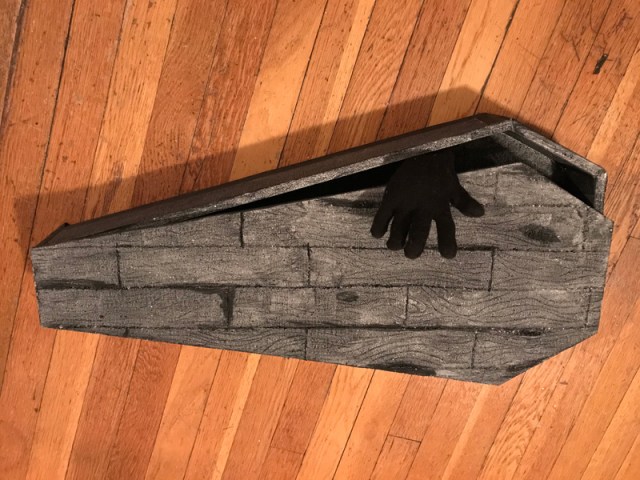
Idea for the hand and hand placement by my wife. October is truly her time to shine.
The Cost
Dollar amount: About $15 for foam and duct tape, and I reused the cheap paint from Project #1.
Time and emotional amount: This took the longest in terms of time spent actively working; I would guess around 4 hours, probably. Despite that, I actually really like building projects on any kind, so this was my favorite of the bunch.
Now all we need to do is buy a ton of candy (even though we live on the second floor and don’t get trick or treaters) and our home will be ready for Halloween. I plan on spending the next week living in a state of nearly constant terror, as I love scary movies but am a total wimp about them. I hope you all enjoy this most wonderful time of the year!
“Hellblade: Senua’s Sacrifice” Joins a Growing List of Video Games That Explore Mental Illness
Some fairly minor spoilers and graphic images below.
There’s a sequence toward the end of Hellblade: Senua’s Sacrifice that’s more moving or triumphant than the climaxes of like half the action movies I’ve ever seen. (Maybe more, even.) As the music builds and swells, Senua, who is battered and broken and barely standing, cuts down wave after wave of opposing warriors. She manipulates time, slowing her enemies down to a crawl as she darts between them with her blade swinging and slashing.
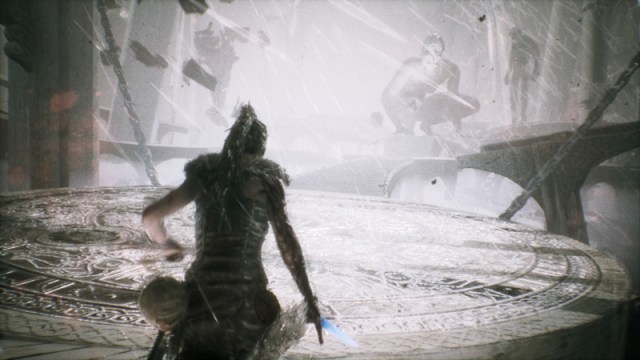
GET ‘EM GIRL
That scene, and others like it, are the very best things about Hellblade. Ninja Theory has created an immersive and stunningly cinematic storytelling experience from beginning to end. There’s no HUD (heads-up display) to track your progress throughout the levels or show the status of Senua’s health, so there’s nothing to distract from the setting — beautiful and awe-inspiring one second and brutally graphic the next — or take you away from the game’s focus on the narrative.
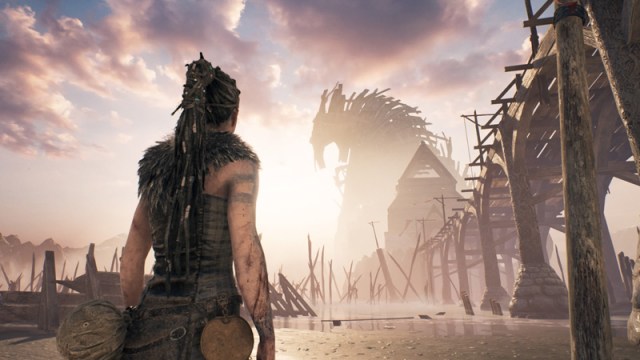
There are some seriously gorgeous shots…

…and also so much gore! Sometimes both at the same time!
And what is Hellblade’s narrative? Well, you play as Senua, a young Celtic warrior on a quest to free the soul of her dead lover, Dillion, from the Old Norse underworld of Hel. But Hellblade is also not about that at all, because Senua is in the middle of a psychotic episode triggered by a pair of traumatic events. She sees things that aren’t actually there and hears voices chattering inside her head, sometimes in a nearly constant stream. Nothing is really straightforward about her journey at all.
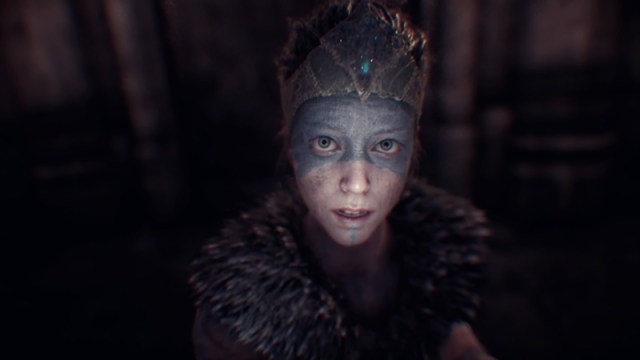
Lexa?
The team at Ninja Theory worked with mental health academics as well as with people who have experienced psychosis to bring the story to life. The symptoms of Senua’s mental illness inform almost all of the game’s mechanics and puzzles. To get through a locked door, Senua must use her “focus” to see naturally occurring runes in her surroundings that match the shape of the runes on the door. Her enemies appear randomly from wisps of smoke, and after the fight they disappear into the ether again. Were they ever even there at all?
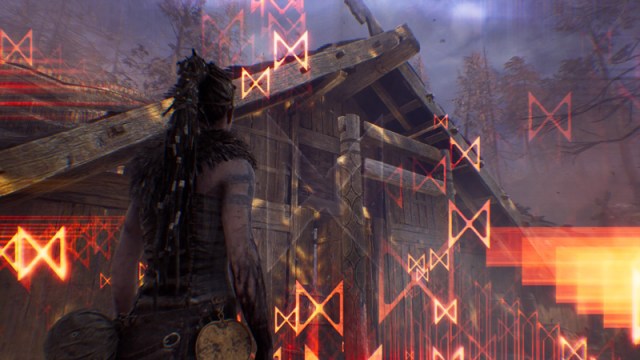
Runes everywhere
I’ve never dealt with this particular type of mental illness, so I can’t say whether their depiction of psychosis is accurate. What I can say is that experiencing Senua’s symptoms kept me off-balance and tense throughout the entire game. I wasn’t sure if I was on the right track to complete a level, and I rarely had any concept of how much farther I needed to go. In fact, I kept thinking the game was “about to end” for almost the entirety of the last four hours of my playthrough. I was terrified to make too many wrong moves for fear of the permadeath promised toward the beginning of the game (more on that later).
Even though all of those elements combined to create dissonance, the chorus of voices in Senua’s head were the most jarring part of the game for me. They belittle and doubt Senua at every turn, constantly whispering “she can’t do it” or “she’s going to die” or another one of any number of equally disturbing sentiments. The sound for the game was recorded using binaural audio, so the voices really do feel like they’re coming from all around you. (Play with headphones on if you can.) I’ve never heard actual voices in my head, but I can definitely relate to feeling like my own worst enemy. I snapped at the voices to shut up more than once. For me, a person who has never experienced psychosis, these things all heightened my senses in a way that felt scary, but still exciting — it wasn’t entirely unpleasant by any means. A reviewer at Polygon who shares some of Senua’s symptoms, however, described her playthrough as “tortuous.”
I’d manage parts of chapters before having to abandon it for a walk around the block … For me, a game like Dark Souls is tense and stressful. Hellblade is something different entirely. I screamed and shouted. I went through a series of symptoms (dissociation, derealization, panic attacks, acute hypervigilance, unshakable feelings of dread).
There’s a moment in the second half of the game when Senua holds up a mirror and you realize that her mouth is moving, even as the words are being spoken by a different voice — deep, booming, and ominous — that has been ostensibly taunting her from the underworld for a while. It shocked me. Because even though I knew or assumed that it wasn’t actually happening, it was still jarring to see the proof. The game moves on from that moment very quickly, but I really wish we had seen more of Senua’s reaction to seeing herself in the mirror. It felt like a missed opportunity for a turning point in her journey.
And then there’s the issue of the “rot.” Early on, Senua loses a fight to some of those magically appearing enemies I mentioned earlier. The game forces you to fail here in order to introduce what becomes a pretty central idea: Senua has become infected with a “rot” in her arm and, if you die in battle, that rot will spread. If the rot reaches Senua’s head, “her quest is over and all progress will be lost.”
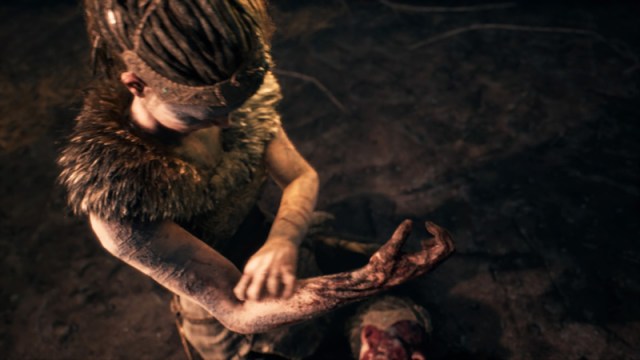
Needs some ointment, tbh
This threat of permadeath really stressed me out as I played, but now I’ve learned that it might all be bullshit. Which, if that’s the case, what the fuck? I do not understand why Ninja Theory would make very specific claims about how their game works and then not follow through on it. Not only is it disingenuous, but, practically speaking, it seems like it was pretty easy to disprove. What I initially thought was a very cool feature, is now something that’s left a sour taste in my mouth since finishing the game. Was this just a gimmick they thought worked well with the theme of reality vs. illusion? If that was the intention, I don’t think it worked here.
Hellblade certainly isn’t the first game to incorporate mental illness into the narrative. While most games that deal with mental illness do so as a way to explain things like a villain’s most erratic and terrifying behavior or justify an in-game mechanic like a “sanity meter” there are a handful of games that actually put you in the shoes of the protagonist as they try to manage their symptoms. Spec Ops: The Line examines PTSD, Sym is a social anxiety platformer, Actual Sunlight, The Cat Lady, and of course Depression Quest explore major depressive disorder. One of the things I’m drawn to most about video games is their ability to build empathy. And I guess in a sense Hellblade is successful. I have now seen how the symptoms of psychosis can affect a person in a little more of a first hand way.
But mental illness is more than a collection of symptoms, and I don’t think the game fully recognizes this. Senua is isolated throughout her journey; we only see how her psychosis affected the people around her in quick snippets of flashbacks. That means we’re missing a whole lot of Senua’s lived experience, so it’s difficult for her to feel like a completely realized character.
I didn’t get the impression that the game was relying on cheap tricks to make you, or Senua for that matter, fully believe in any illusions of reality on her quest. Senua is aware that she hallucinates and has been dealing with her mental illness for most of her life. She knows that the voices tearing her down aren’t “real” in the literal sense, but she isn’t able to tune them out or ignore them. You can see — and feel — her anguish as she tries to keep battling onward.
This Queer House, Vol 6: Of Mice and Murder
I do not like mice. I mean, I am obviously aware that they can be kind of cute and even smart, but you know what? There are a lot of animals that are even cuter and smarter, and they don’t try to hang out in my apartment uninvited. It’s like, do you pay rent here? Do you do the dishes? You absolutely do not, mouse. All you do is make me feel unsafe in my own home.
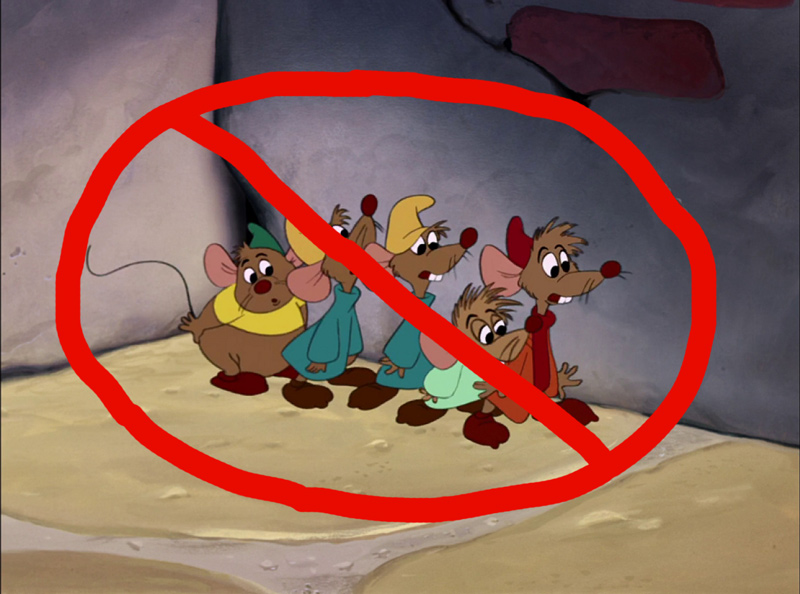
Yes, I am aware this is technically a cartoon, BUT THE SENTIMENT STANDS.
My wife and I have been living in the same apartment for three years and, up until recently, we had been blessed by the Mouse Powers That Be. Never once had we seen or heard any sign of pests whatsoever. I think you probably know where I’m heading with this, but I’ll tell you the facts anyway.
The beautiful sanctity of our apartment was cruelly dashed a few weeks ago when Steph, my wife, woke up to a grisly murder scene in our dining room. The perpetrators, aka our cats, did a real number on the “victim” (though I use that term loosely). And even though our cats are obviously heroes (and so is my wife because she did not wake me up before disposing of the body), the damage is done. The illusion of safety has been shattered and now I’m a paranoid mess who runs their robot vacuum maid (Rosie the Roomba) for protection almost every day.
So, what can you do to protect yourself from the same nightmare that has befallen me?
Preventative care around your home
Keep it clean. Here’s the thing: mice are going to be around, especially if you live in a city. As much as I wish it were not the case, there’s just no getting around that. My whole thing is just to hope that someone else’s apartment is more appealing to a mouse than mine is. To that end, I recommend cleaning regularly and storing food in airtight, unchewable containers whenever possible.
Figure out where mice could get in. If you have have any holes in your walls, take a look at last month’s This Queer House and fix them. If there are gaps in other places (like near pipes or under your cabinets or appliances), you can seal them with caulk or stuff them with steel wool, which mice cannot chew through. Make sure you look really hard for gaps! Those little fuckers can get through tiny spaces, like even one the size of a dime.

Actual steel wool in my actual kind of crappy kitchen
Get a cat!

Look at my little murder bbs I love them so much
Natural mouse remedies
Peppermint oil. I have read that mice do not like the strong smell of concentrated peppermint, so one thing you could try is to soak cotton balls in peppermint oil and leave them in susceptible areas of your home. I honestly do not know if this actually works, but even if it doesn’t it’ll leave your house smelling minty fresh so there’s really no downside.
Used kitty litter. I guess this is a thing people do. Not sure if there’s a black market for cat piss or anything, so you’re on your own there.
Less natural, but not murder-y
Ultrasonic Pest Repellents. These are things that plug into the wall and emit high frequency ultrasonic waves, which allegedly keep rodents (and other pests) away. However, Steph told me that she once watched a mouse casually amble across her dorm room floor, with no fucks to give, TOWARD one of these things, so I make no guarantees about their effectiveness.
Non-kill traps. I have heard that these traps work great as long as you bait them well (peanut butter seems to work best), but I’m not a huge fan for a few reasons. One, you have to deal with a live mouse at some point. Hard pass from me on that front. Also, like, where are you going to release that thing? How far do you need to go so that it doesn’t just immediately come back inside? Seems like A Lot™ in my opinion.
Burn them all with fire
Bait traps. These were recommended to me after my recent scare, but I haven’t tried them out yet. The premise is that the mouse comes into the trap and takes the bait (poison) and then they go die somewhere else. This could either be a very good or very bad thing depending on where that somewhere else is.
The “Rolling Log” bucket trap. I watched a youtube video about this and honestly I’m pretty scarred, so I don’t want to talk about it. The video is called “11 Mice In One Night. The Rolling Log Mouse Trap In Action. Best Mouse Trap Ever,” and you can check it out here (cued up to where the action starts), if you’re into that sort of thing.
Classic snap traps.

I hope things go better for you than they usually do for Tom
Ah yes, the Tom and Jerry Gold Standard. If you didn’t know already, I’m a total wimp about mice (and most things tbh) so I have never actually used one of these. It’s probably gross to clean up, but if you are planning to kill your rodent intruders this kind of seems like the best way to do it.
NOT recommended
Sticky traps. Listen, I know there is a section of this column called “Burn them all with fire,” but sticky traps seem inhumane even to me. Let me tell you a little story about one of the worst nights of my life. When Steph and I were just wee little scamps in college sharing a twin-sized bed, all of the mice in my neighborhood decided to mount a calculated attack on my apartment.
I won’t go into all the details, but there were at least five mice spotted in a span of like maybe twenty minutes one night. I ended up crouched on top of my toilet wearing nothing but underwear and galoshes. Steph ended up throwing a mouse on a sticky trap (that was trying to chew its own arm off) out my second story window into the dumpster below. We all do things we’re not proud of in the heat of battle, okay? Anyway, the point is just don’t get sticky traps.
Welp, fucking good luck out there. Do you have any other tips? Share them in the comments, please, for my sanity.
This Queer House, Vol 5: How to Patch Walls and Other Easy Moving Tips
Happy Back-to-School season! Even though I finished school some time ago, I still get excited around this time of year. For me, September will always feel more like a new beginning than New Year’s Day. I don’t know if it’s like this where you live, but here in Boston September 1st also means that everyone and their mom is moving. Specifically, it means Allston Christmas and U-Haul trucks getting stuck on Storrow Drive and convincing friends to perform several hours worth of manual labor in exchange for beer and pizza.
If you’re moving this fall, one way to help ensure that you get a full security deposit back from your landlord or management company is to repair any obvious issues in the apartment. In this month’s This Queer House, I’m going to take you through one of the easiest cosmetic fixes — patching small holes in your walls — and talk about a few other ways to leave your apartment looking as un-beat up as possible.
What you’ll need:

- Spackle – I happen to just have Vinyl Spackling, but if you are either impatient or new to the process you might want to check out the kind that has Dry Time Indicator. It goes on pink and dries white, so you don’t have to worry if it’s ready to sand or paint. (I have some feelings about why they made the “easy version” spackling pink, but I’m not going to get into that right now.)
- Putty knife or similar tool – I used a 5-in-1 tool for this and it worked fine.
- Sandpaper – You definitely don’t want to use sandpaper that’s too rough – between 100-150 grade should be good. (I used 120, if you were wondering.)
- Painting supplies (optional) – If the wall wasn’t white (or close to it) to begin with, you’re going to want to paint over the patch.
What to do:
1. Assess the damage. I’m going to illustrate how to fix any hole or gash that is approximately half an inch or less in diameter (basically just about any kind of nail or screw hole). If you’re looking to patch something larger, skip down to #5 for some more information about that.

No, *YOU* made a hole in your wall just to repair it for a DIY column.
2. Apply spackle and let dry. If the hole is on the larger side, you might want to apply one layer of spackle to fill it up. Then let that dry and apply a second layer to make it is fully covered. If it’s just a small nail or thumbtack hole, one layer should be fine. Make sure to apply the spackle thick enough to cover the hole, but keep in mind that the thicker the bump the more you are going to need to sand it down to even the wall out. Don’t get too wild with it, is what I’m saying. Check the packaging for any exact specifications in terms of drying time and temperature/moisture restrictions.

Applying the spackle.
3. Sand the surface down to match the wall. Be gentle and use your fingers often. (HEYO) But seriously, no need to apply a ton of pressure right off the bat because this stuff should sand really easily. As you’re sanding, run your fingertips across the wall to check for smoothness.

After sanding.
4. Paint patch to match wall color. (optional) There are a lot of variables for this step. If the walls are close enough to white, you can probably get away with not painting over the patch. If the walls are dark or vibrant and the patch is really obvious, I sure hope you have the exact paint (or at least know the exact brand/shade) that was used in the first place. If not you can try to match it, but that’s a real gamble and you might end up having to paint the whole room.

I bet you can’t even tell where the hole used to be! I put arrows to help you, don’t worry.
5. What do I do if I have larger holes in my walls? For anything bigger than about a half an inch or so, you’re going to want to add some extra stability before you spackle the hole. A ton of different brands sell kits with instructions that should have you covered up to about 6in or so in diameter. Basically, you just apply a self-adhesive fiberglass patch over the hole and then cover it all up with spackling (multiple layers, letting each layer dry between coats). In this case, you do want to use extra spackling and cover an area larger than the patch by a few inches. That way as you’re sanding, you can gradually feather the edges to meet the wall and make any slight bump less obvious.
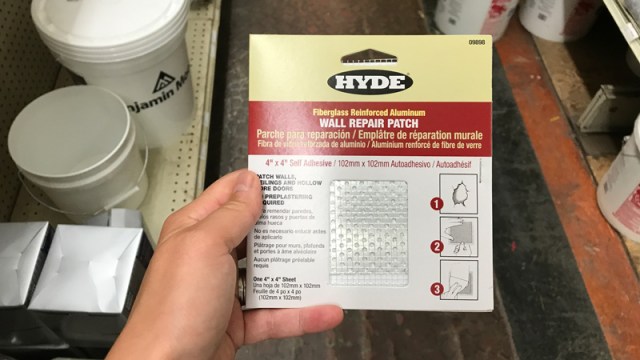
I almost bought this, but then I decided I did not want to create a several inch wide hole in my wall.
If the hole is bigger than six inches, what are you even doing in your apartment? I am not equipped to help you with that.
Other staples for when you’re moving and you want your security deposit back:
- Magic Eraser – Listen I wanted to hate this product, but it actually is fucking magic. Use this on any aggressive stains in your apartment and no one will know how many parties you had.
- Wood stain pencils or markers – These can come in handy for any obvious scrapes or scratches on wood floors that you didn’t notice until you moved the furniture.
- Trim paint – If the paint matches (or is very close to matching), you can touch up any obvious scrapes or chips without re-painting everything.

Before and after one really quick/semi half-assed paint job. Looks a lot better with almost zero effort!
Well there you have it, fellow queer renters. I hope these tips help you get back your full security deposit whenever a U-Haul is in your future.
“Tacoma” Isn’t “Gone Home” But It’s Got a Queer Couple and a Beautiful Story to Tell
Once upon a time, there was a game called Gone Home and it was tense and surprising and queer and good. I played it about a year ago, just after devouring Life is Strange for the first time, and I will always remember it as one of the games that awakened my decade-dormant video gaming enthusiasm. So, there’s a chance that I’m slightly biased when I say that if playing Gone Home felt like catching lightning in a bottle then Tacoma, Fullbright’s recently released follow-up, seems more like looking at fireflies trapped in a jar.
If you also played Gone Home, you will immediately recognize that most of the basic mechanics and gameplay of Tacoma are very similar. (If you haven’t played Gone Home, it’s on sale for less than $5 on Steam right now so: jennifer-love-hewitt-what-are-you-waiting-for.gif?) Tacoma is a first person exploration game set in the near-ish future (the year 2087). You play as Amitjyoti “Amy” Ferrier, a subcontractor tasked with recovering AI data from an empty space station. While you wait for the data to upload at various ports in the station, you explore the station looking for clues about the crew and what happened to them.
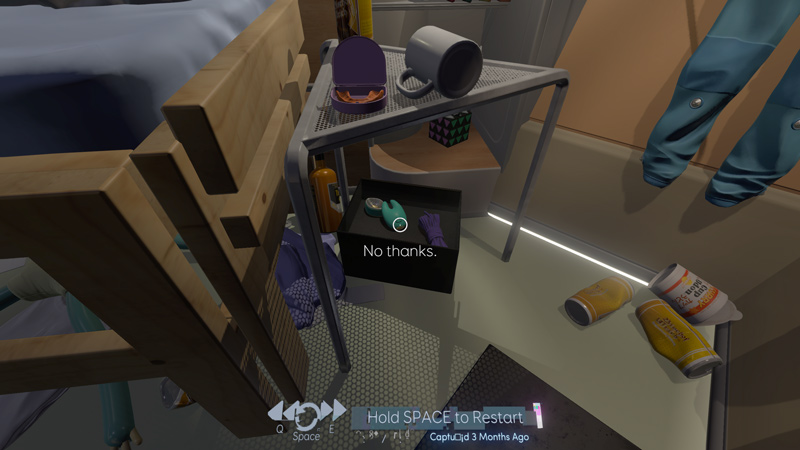
Look for clues OR snoop around and find sex toys, your choice.
The objects scattered around Tacoma range from somewhat mundane world-building items, like a drink packet for a “house red” wine, to character-specific details, like a letter from a crew member’s mom back on Earth. The former can start to feel repetitive, just because of the amount of stuff packed into the station, but stumbling upon the unique artifacts is consistently a joy. These objects, like the vibrator (pictured above) hidden near a married queer couple’s bed, do a great deal to give depth to characters you never actually get to meet.
The major difference in gameplay between Gone Home and Tacoma is the addition of AR Crew Record Data, which manifests itself as holographic video that you can play (and fast-forward/rewind) to piece together scenes from multiple crew members’ perspectives. You can follow characters in and out of rooms, listen to overlapping conversations, and interact with additional recovered “desktop data” when it’s available — like messages between crew members or notes a character has taken.
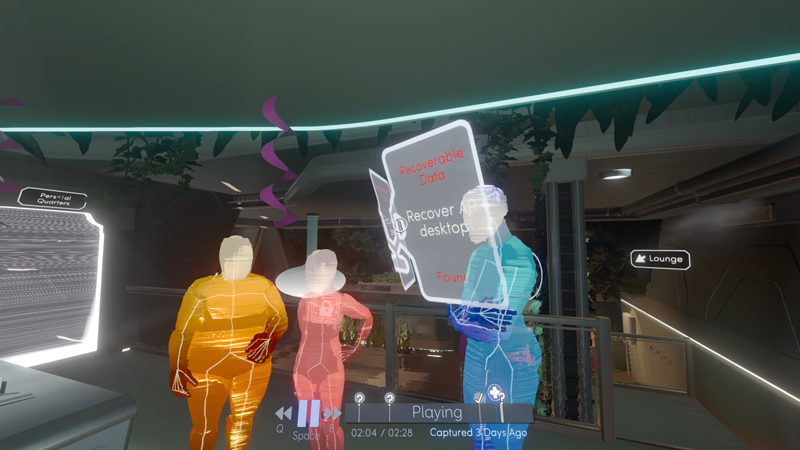
You get used to the faceless color-coded people, I swear.
Recovered AR data comes in bits and pieces; there’s a mix of scenes that depict the hours leading up to and immediately following a catastrophic event onboard, as well as clips from weeks, or even months, earlier that round out the characters or advance the plot. It’s an inventive and compelling bit of nonlinear storytelling that I found really enjoyable. That being said, the actual substance of the story fell a little flat for me. Don’t get me wrong: I was interested in the game and invested in the well-being of the crew (mostly the queer women and the cat, tbh, because I’m a walking stereotype), but the overarching world seemed a little off or underdeveloped.
See, one of the best things about Tacoma, in theory, is the way the game allows a diverse cast of characters to simply exist without it being a thing. In this world, Nat and Bert are women with their own unique flaws and strengths that have nothing to do with the fact that they are queer. They argue and they kiss and they laugh and they care very deeply about each other, all while trying to save the day in a life or death situation.
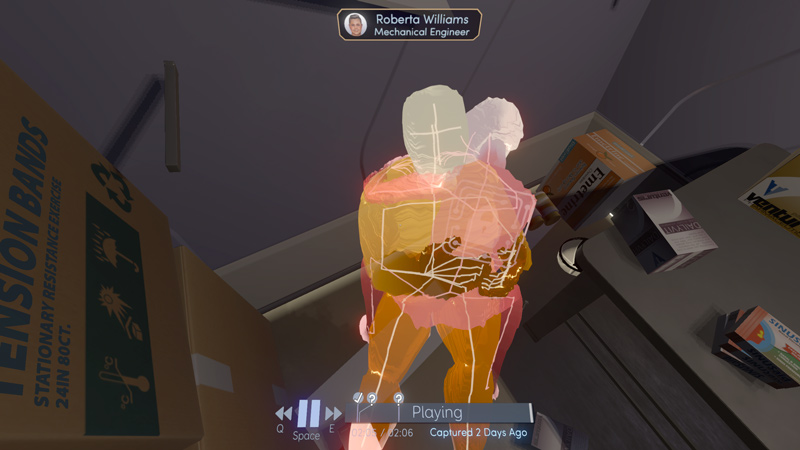
ABS. Always Be Straddlin’.
This novel concept isn’t exclusive to Nat and Bert; the rest of the crew is equally well-rounded and diverse without much fanfare. And maybe it’s because the actual 2017 world we live in is such a brightly burning garbage fire, or maybe my own cynicism is clouding my view, but Tacoma’s portrayal of 2087 felt inconsistent. It’s difficult for me to imagine that most people have apparently evolved beyond racism and homophobia in a short 70 years, especially when the game actually does acknowledge and use other systemic issues as part of the plot, like the perils of capitalism.
The other thing that adds to the semi-unfinished feeling of the game is the sheer size and complexity of the world it has built. Where Gone Home centered around a single family in ’90s, with most of the focus on the sister, Tacoma has to establish an intricate future setting while telling a story about six main crew members (along with some of their family members), an artificial intelligence, and the corporation that owns the station. It’s a whole lot to take in, especially for a game that took me less than five hours to play (but that number could vary pretty significantly depending on how much time you spend exploring).

Look at how much info is packed into this one object!
Despite the issues I had with some of the plot and world-building, I did still enjoy this game. Tacoma isn’t perfect, but it is certainly ambitious, and I appreciate that Fullbright seems committed to telling stories that don’t center around straight white men. Tacoma feels like a necessary, if somewhat shaky step forward for Fullbright, and I’m looking forward to what they do next.
Tacoma is available on Xbox One and Steam.
Teenage Girls Create Murder, Mayhem And Queer Love Stories With Girls Make Games
Have you ever heard of this thing called Girls Make Games? it is “a series of international summer camps, workshops and game jams designed to inspire the next generation of designers, creators, and engineers.” How rad is that? When I was young, I didn’t know any other girls who even played video games. I can’t imagine how amazing it would have felt to be surrounded by game-loving and creative peers!
Girls Makes Games U.S. summer camps are just finishing up this week in 14 cities across the country. In August, teams will present their game demos to a panel of industry judges, and a winning team will be selected to launch a Kickstarter campaign. 2015’s winning game, Interfectorem, raised over $12,000 and is now available on itch.io Steam.
I played Interfectorem not really knowing what to expect from the project’s final outcome and I was really pleasantly surprised. It’s a point and click murder mystery/visual novel (with some other minor elements of gameplay) and, even though it’s only an hour or so of play, it’s a joy to experience. The art, done by Reimena Yee (who has done covers for both Lumberjanes and Adventure Time!), is a real standout and I found myself pausing mid-play to admire screens.
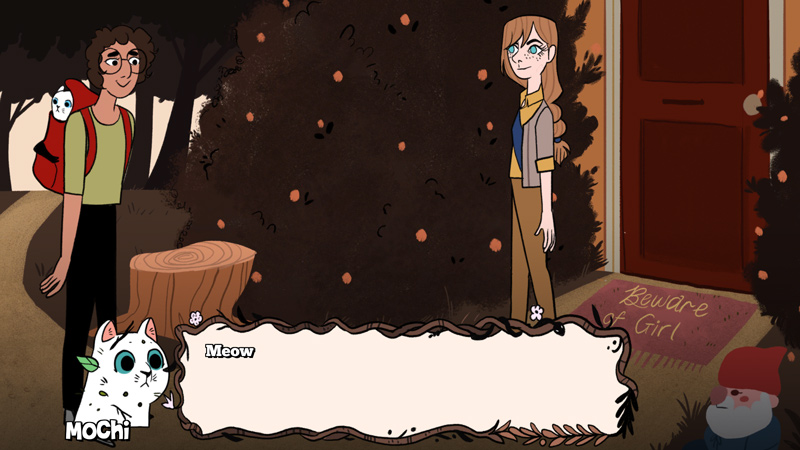
I also liked Mochi the cat very much.
The game doesn’t shy away from the “murder” part of murder mystery, and it becomes graphic and bloody pretty early on. It’s funny, even though I was into horror movies as a kid, and even though I have tried really hard to unlearn all the gender stereotypes society drilled into my head, I still found myself surprised by the gore in Interfectorem. I sure did not expect that kind of blood in a game made by a team of 10- to 14-year-old girls. But you know what? I loved it, and I want to thank them for subverting my expectations and reminding me gender stereotypes are dumb.

Brutal.
Interfectorem is a female-focused new take on a classic story about avenging a slain family member. In this case, the main character is Alis, a young sheriff-in-training, and she’s out seeking justice for the murder of her little sister, Sali. The characters break the fourth wall often, and you can tell the team had a lot of fun writing and creating this game.
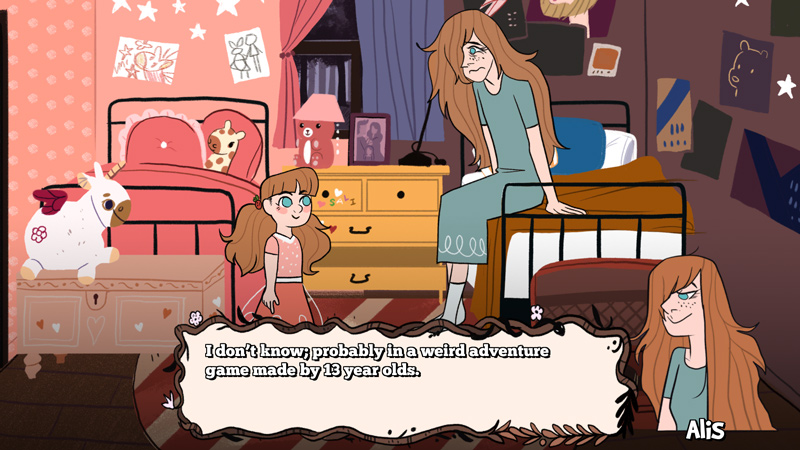
Meta! Maybe one of these kids should write The L Word reboot.
Also, y’all, this is one of the most diverse games I’ve played in… maybe ever? There are characters with different racial backgrounds, characters with disabilities, characters with a variety of body types and sexual orientations. It doesn’t seem forced or unnecessary; it feels totally natural, like a reflection of the world around us. (Major video game studios: please take note.) Plus, there’s a queer love story and it that’s just adorable as heck.
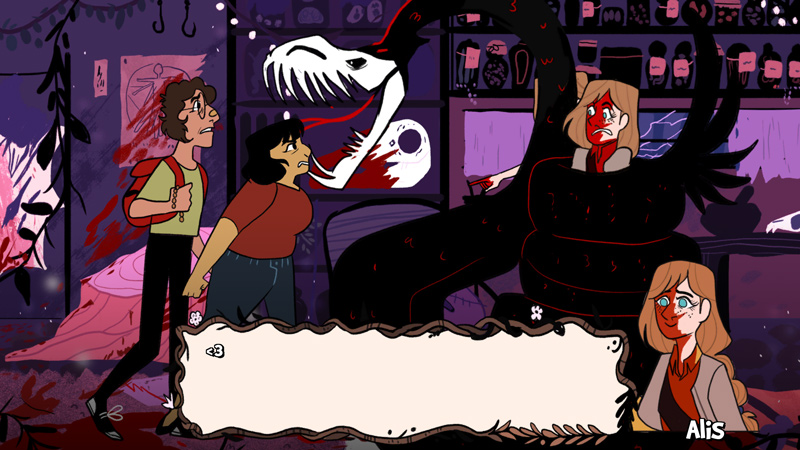
<3 Snake Monster Fighting Girlfriends <3
Overall, if you’re looking for a refreshing, fun, and quick game that will support a wonderful program, I definitely recommend checking out Interfectorem. It’s only about $5, and it honestly feels like an investment in the future of video games.
The 2016 winner was Kickstarted late last year with pledges of over $32,000.(!) It’s not out yet, but it’s called BlubBlub: Quest of the Blob. It looks fun and cute, but is also about thwarting a “scheme for building a cosmetics empire.” So, it’s probably also like an allegory about the perils of capitalism, because I’m pretty sure these kids are all smarter than I am. You can keep up to date with BlubBlub on their Facebook page and be the first to know when the game will be released.
This Queer House, Vol. 4: Easy Wood Restoration
Once upon a time, when my wife Stephanie was still my girlfriend, we moved (on very short notice) from Washington, DC to Boston into an apartment we had never seen in person before. The next few months were absolutely wild — full of packing and unpacking, new job situations, and last minute wedding planning/crafting. After things calmed down, Steph and I finally had a chance to assess our apartment, which was bigger than anywhere we had lived before. Big enough, in fact, that we had a whole extra room and no furniture to fill it.
So, like the good queers we are, we found ourselves in a rented U-Haul truck on New Year’s Eve 2014, heading to meet a man about a cheap Craigslist dining room set. The furniture was more than a little gently worn from years of use, but it was a solid set that just needed a little extra love. The technique I used then (and re-created more recently to freshen it up) is not a full restoration — I did not sand everything down and start from scratch. What we’re doing here is more like restoration-lite, but it should be enough to salvage a Craigslist (or yard sale or attic) find nine times out of ten.

2015 Before pics. Pretty rough shape.

2017 “Before” pics. Not as bad, but not great.
What you’ll need:

This is the most awake/excited Ellie has ever looked in her whole life! Clearly a fellow DIY lover!
- Murphy’s Oil Soap – This is really the best, 10/10 would recommend keeping a bottle for random projects around the house.
- Lemon or Orange Oil – I have heard that it’s not too hard to do a homemade version of this. If anyone out there has tried it, please advise in the comments.
- Steel Wool – Grade #0000
- Rags – I always cut up old t-shirts as needed, because I have way too many.
- Denatured Alcohol – Optional
- Paste Wax – Also optional, but recommended
- Hardware (cabinet knobs or pulls) – Optional, dependent on project
What to do:
1. Remove hardware (optional). If you’re replacing knobs or pulls, take them off now so you can clean the furniture really well without them.
2. Scrub it down! Use about ¼ cup of the Murphy’s for every gallon of water, mix it all up in a bucket, and give the furniture a deep cleaning. When I was a kid, I always thought my mom was crazy because she used extremely hot water when she did the dishes. I have apparently become my mother (BUT ONLY IN THIS VERY SPECIFIC WAY) because I nearly burnt my damn hands washing the furniture. But you know what? I really do feel like hot water gets things cleaner, so I’m going to go ahead and recommend you use the hottest water you can stand here. (My wife very intelligently suggested wearing gloves for this. Great advice that I did not follow!) Also, have a dry rag handy at all times, because you don’t want to let a lot of excess water sit on the wood. Use the classic wax on, wax off technique, is what I’m saying.
3. Use denatured alcohol to remove water stains (optional). The most important thing about this step, if you’re doing it, is to use as little alcohol and force as possible so you don’t totally strip the finish. Dip a tiny corner of a clean rag into the alcohol and let it seep into the material before you start to very gently rub at the water stains.
4. Buff it with steel wool to remove any other stains/paint/dirt/etc. This step also requires a light touch; you basically want to affect the wood as little as possible while still getting the desired result. Go with the grain of the wood and do what feels right. At this stage, your furniture is probably going to look even shittier than when you began. That’s okay! Everything is going to be fine.

If it looks like this, you didn’t ruin anything probably!
5. Replace hardware (optional). When I lived in DC, one of my very favorite places was Community Forklift, which is a nonprofit reuse center for home improvement supplies. They have a huge warehouse, and it’s full of all sorts of treasures! When we moved to Boston, I was bummed to say goodbye, but I found out recently about Habitat for Humanity ReStore and bought my hardware there! It’s really similar to Community Forklift and also there are locations all over the US! Go forth! You’ll be supporting a good cause while getting home improvement supplies for cheap.

Pre-hardware replacement buffet.
6. Clean it again. Get back at it with the Murphy’s to remove any steel wool dust/dirt/etc. (Same as step 1.)
7. Polish with citrus oil of your choice. Depending on the brand or type of oil the directions might differ slightly, so just do whatever the bottle tells you. This stuff smells nice and makes the wood look real shiny and new!
8. Finish with paste wax (optional). I had never used this before, but I decided to give it a try this time and I really liked the finish. The end result is less high gloss and more of a luster, which I really like. You might want to test this on a small less-visible part of the wood to see if you’re into it before committing to buffing it onto your whole piece.

I fucking love my dining room, y’all.
So there you have it! Please bear in mind that this tutorial isn’t going to save every piece of old wooden furniture in the world. If you find something that is deeply scratched or stained — and you want it to look brand new — you’re probably going to need to do a lot of power sanding instead. I happen to think perfect can be very boring, though, so I love using this easy technique to extend the life of old furniture and I hope you do too.
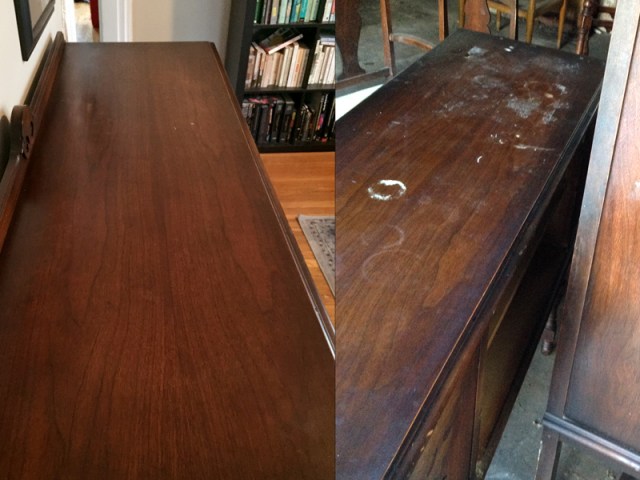
Buffet after and before (2015).
“What Remains of Edith Finch” is Trying to Break Your Heart
The most important thing I should tell you is that What Remains of Edith Finch is a game, yes, but it is first and foremost a story. Specifically, it’s a story about stories—about their power, about their weight, about the effect they have on those who wield them and those who hear them. It’s an experience that reminded me just because something isn’t true, that doesn’t mean it’s not real.
You play as Edith Finch, the last living member of her large family. Throughout their history, Finches have done two things consistently: they tell stories, and they die, often tragically or mysteriously. Edith’s mother thought that the two were connected, that the stories perpetuated some kind of family curse, so she sealed up the bedrooms of dead relatives and turned their family home into a living mausoleum. But Finches kept dying, and now Edith is back after some time away to unearth the secrets that live on in the house.
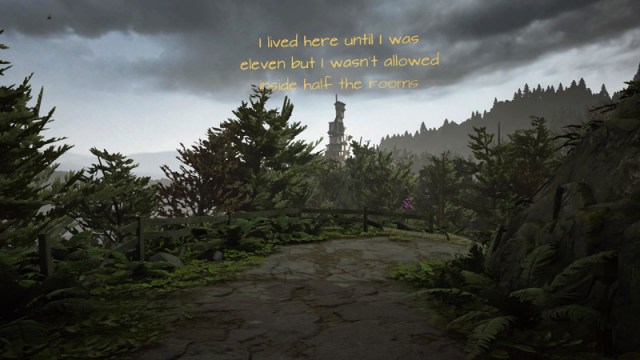
What Remains of Edith Finch is a visually stunning game. I’ve seen some folks complain about performance issues on PS4, but they honestly did not bother me. I think it might be because I’m very used to old graphics, so my standards are lower. If performance is something you’re super conscious of and you have the ability to play on PC, it seems like that’s the better option.
Despite a few noticeable glitches, I still found the artwork to be absolutely gorgeous. Set on an island in the Pacific Northwest, the scenes surrounding Edith are always brimming with life. Exteriors are rich, full of lush greenery and choppy water, while the interiors are even more textured and elaborate. The Finch house feels real and lived in, and it’s as much of a character as any of its past inhabitants.
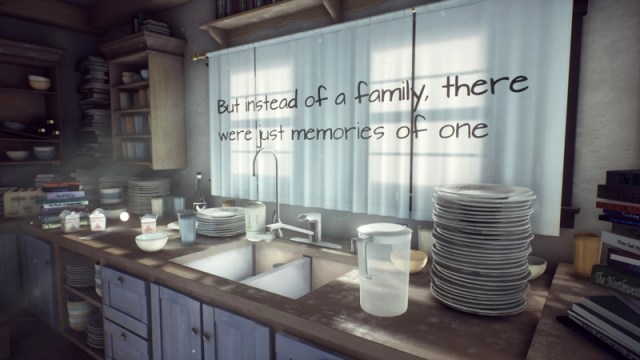
Throughout the game, Edith narrates her experiences as she documents the Finch history—both hers and her family’s, the truth and the fiction. These words appear scrawled in the environment around you as you explore, physical reminders that you’re experiencing it all through someone else’s lens. Sometimes you can interact with the words, but more often than not the letters simply scatter into the ether.
The gameplay is extremely simple; except for a few instances, you really only have to walk around the house and interact with highlighted items using one button. It’s a first-person exploration game, which I enjoy, but may cause motion sickness for some people (like my wife).
The overall concept of the game is immediately reminiscent of Gone Home: a young girl explores an empty house to figure out what happened. I loved both games, and I understand the comparison, but their tones couldn’t be more different. Gone Home is tense and mysterious—it feels like something terrible could happen to you at any moment—while What Remains feels quiet and full of melancholy. The other major difference between the games is how you learn about the events that took place in each house. Where Gone Home relies on audio clips and objects to shed light on prior incidents, What Remains actually pulls you into the past and lets you relive it.
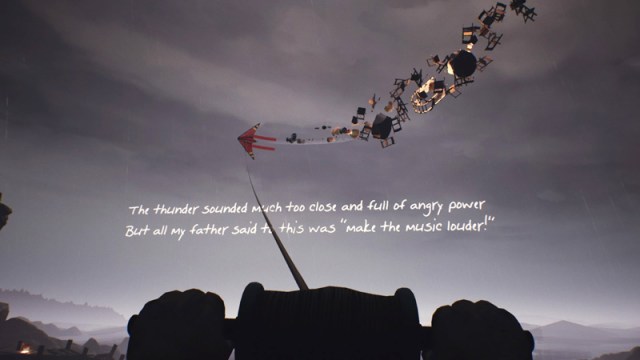
These vignettes, the tales of how each Finch died, are where the game really excels. While some stories are stronger in gameplay and/or narrative than others, the collection as a whole is extraordinarily inventive and honestly just a joy to experience. I loved how the game mechanisms for each tale are totally different. For instance, one story has you zoom and focus a camera to capture the moments leading to someone’s death, while another requires you to pump your legs back and forth to power a swing set. There are about a dozen of these scattered throughout the game, and, with just a few exceptions, they had me enraptured.
You go into each one of these vignettes absolutely knowing the outcome, so there’s a looming feeling of inevitability as you play. You are sure that you are marching each Finch toward their death, and you want to do something different, but these stories have already been written. A few of the scenes made me feel visceral, physical anguish, which is a testament to how well they were crafted. I even had to take a break after Gregory’s scene, the Finch who died youngest.
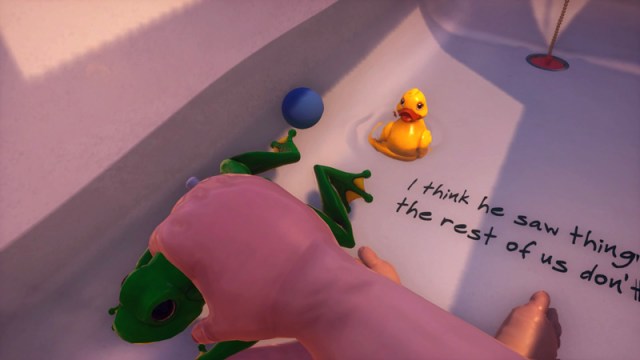
The story of how Edith’s brother, Lewis, died is the most well-crafted — in both content and gameplay — and it’s also the most upsetting. Lewis was a half-Indian, bisexual kid with substance abuse issues living at home in a rural town. He had an unfulfilling job at a cannery, and he used his time there to let his mind wander in a vivid daydream. In this world, he was a well-loved and successful traveler, visiting faraway lands in search of a beautiful prince or handsome queen. You control the daydream with one hand, while your other hand is back in a strikingly different and stark reality: at the cannery, repetitively slicing the heads off of fish.
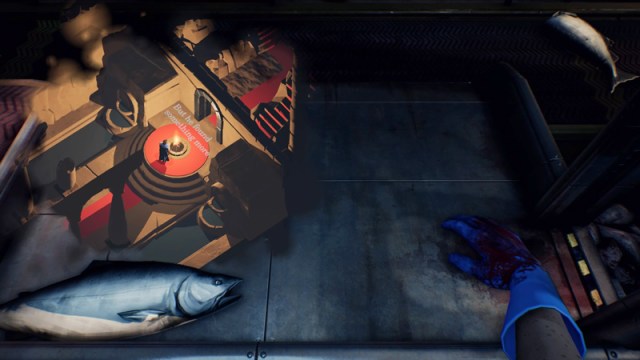
Though I mostly loved What Remains of Edith Finch, there were are few missteps. Edith’s father was an Indian man named Sanjay, but he is barely mentioned. Before Sanjay, the Finch family was entirely white and it seemed odd to me that the game didn’t explore his experiences entering into the Finch clan, or discuss Edith and her brothers’ identities in any detail. Similarly, the game mostly ignores Sanjay and the other people who married into the family. We only learn little things about their lives in passing, and we do not get to see how they died. A family is about a lot more than blood, and I would have liked for their stories to be included.
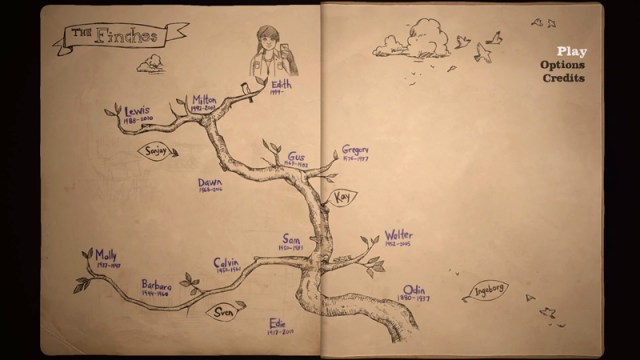
“Non-Finches” are only represented by leaves :(
How you feel about the ending of What Remains of Edith Finch will likely depend on your personal experiences with family, secrets, and stories. Death is the only sure thing in this world, so is the Finch family really more special, or more cursed, than any other family? Edith, like her great-grandmother Edie before her, believes in the importance of storytelling, so she makes sure to document the Finch family history for any and all future generations. Edith believes it is a privilege to be alive and experience any of life at all—the good and bad, truth and fiction, joy and sorrow—and there’s something heartbreakingly beautiful in that.
What Remains of Edith Finch is a little pricey for the length of gameplay — about $20 for 2 or 3 hours — but it’s an experience that will stay with you long after the game is over. You can find it on PS4 and Steam.
